Introduction to Counselling theories
VerifiedAdded on 2023/01/10
|52
|8271
|1
AI Summary
Please use Study Book and Study guide to complete the answers in Assignment
Contribute Materials
Your contribution can guide someone’s learning journey. Share your
documents today.
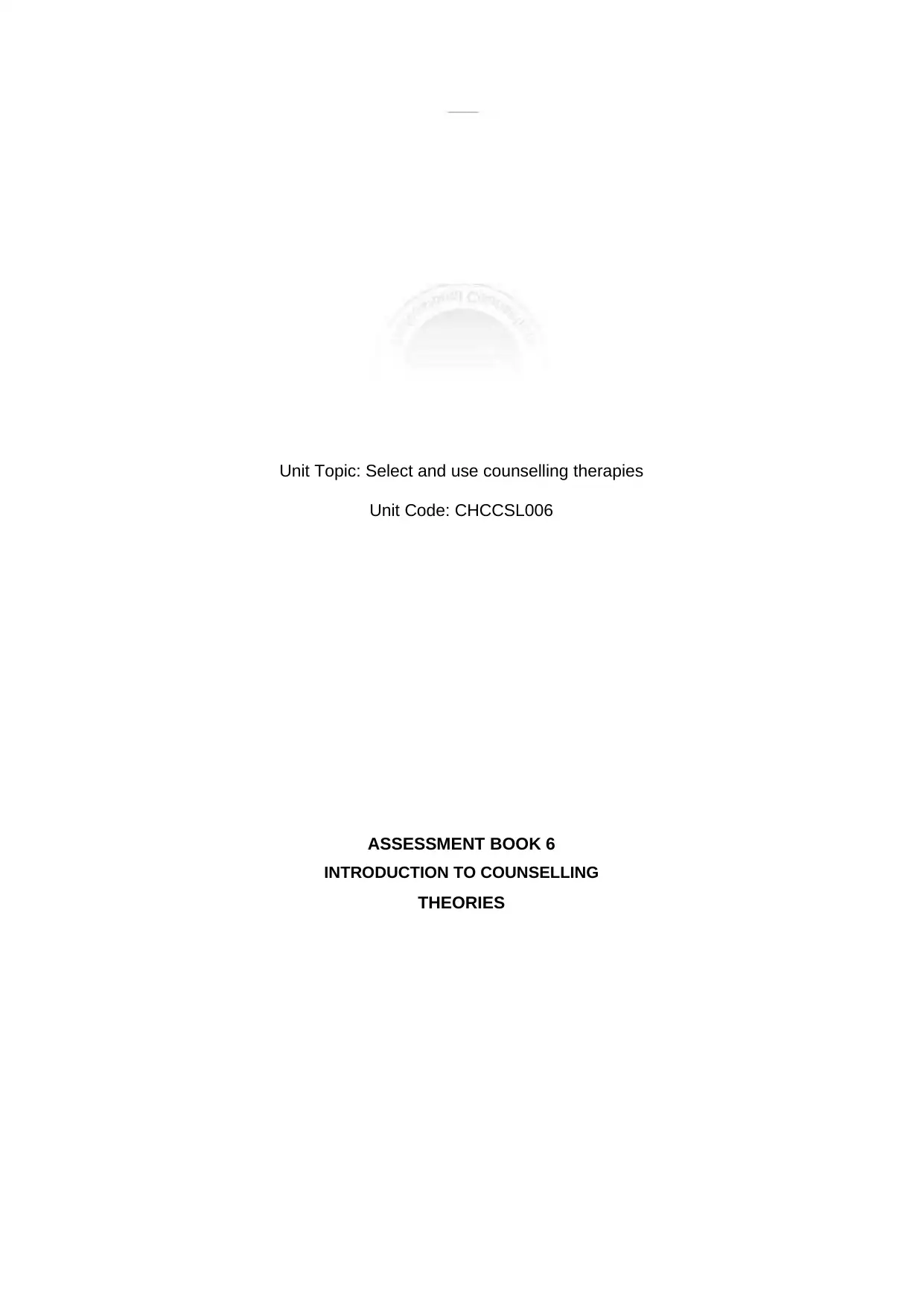
Unit Topic: Select and use counselling therapies
Unit Code: CHCCSL006
ASSESSMENT BOOK 6
INTRODUCTION TO COUNSELLING
THEORIES
Unit Code: CHCCSL006
ASSESSMENT BOOK 6
INTRODUCTION TO COUNSELLING
THEORIES
Secure Best Marks with AI Grader
Need help grading? Try our AI Grader for instant feedback on your assignments.


Assessment Instructions
All of the information that you need to complete your assessment
tasks are included in your Study Guide and associated Readings.
Before attempting to complete this Assessment Book you must read
through all of the information supplied to you in the Study Guide and
Readings for this unit. You are required to complete all assessment
questions successfully in order to be deemed competent in this unit.
This Assessment Book is designed to assess your knowledge. Copying
sentences and blocks of text directly from your Study Guide, Readings, or
other documents does not demonstrate your understanding of the topic.
Neither does copying the work of another student. Such practices are
regarded as plagiarism and will not be tolerated. (Please see your
Student Handbook for further information regarding Plagiarism).
A guideline for the number of words required for a response is included
to give you an idea of the depth of information that is required to
successfully answer the question. If you are well under the approximate
number of words you may need to ask yourself whether you have been
too superficial in your response. If you are well over the word limit, then
you may need to ask yourself whether you have included irrelevant
information or repeated yourself unnecessarily. If you do not understand
what is required for you to complete an assessment, please contact an
Education Adviser.
Submitting an Assessment
Book
Please submit your assessment book via your online student portal at
http://my.aipc.net.au
Use the following as a checklist before submitting your Assessment Book:
Have all of the questions and activities been completed?
Is your name and student number noted in your Assessment Book?
(on the following page)
Have you completed the Candidate Declaration? (on the following
page)
Have you saved a copy of all of your work (in case of loss)?
Thank you for choosing to study with the Australian Institute of
Professional Counsellors. Best Wishes!
All of the information that you need to complete your assessment
tasks are included in your Study Guide and associated Readings.
Before attempting to complete this Assessment Book you must read
through all of the information supplied to you in the Study Guide and
Readings for this unit. You are required to complete all assessment
questions successfully in order to be deemed competent in this unit.
This Assessment Book is designed to assess your knowledge. Copying
sentences and blocks of text directly from your Study Guide, Readings, or
other documents does not demonstrate your understanding of the topic.
Neither does copying the work of another student. Such practices are
regarded as plagiarism and will not be tolerated. (Please see your
Student Handbook for further information regarding Plagiarism).
A guideline for the number of words required for a response is included
to give you an idea of the depth of information that is required to
successfully answer the question. If you are well under the approximate
number of words you may need to ask yourself whether you have been
too superficial in your response. If you are well over the word limit, then
you may need to ask yourself whether you have included irrelevant
information or repeated yourself unnecessarily. If you do not understand
what is required for you to complete an assessment, please contact an
Education Adviser.
Submitting an Assessment
Book
Please submit your assessment book via your online student portal at
http://my.aipc.net.au
Use the following as a checklist before submitting your Assessment Book:
Have all of the questions and activities been completed?
Is your name and student number noted in your Assessment Book?
(on the following page)
Have you completed the Candidate Declaration? (on the following
page)
Have you saved a copy of all of your work (in case of loss)?
Thank you for choosing to study with the Australian Institute of
Professional Counsellors. Best Wishes!

3
Secure Best Marks with AI Grader
Need help grading? Try our AI Grader for instant feedback on your assignments.
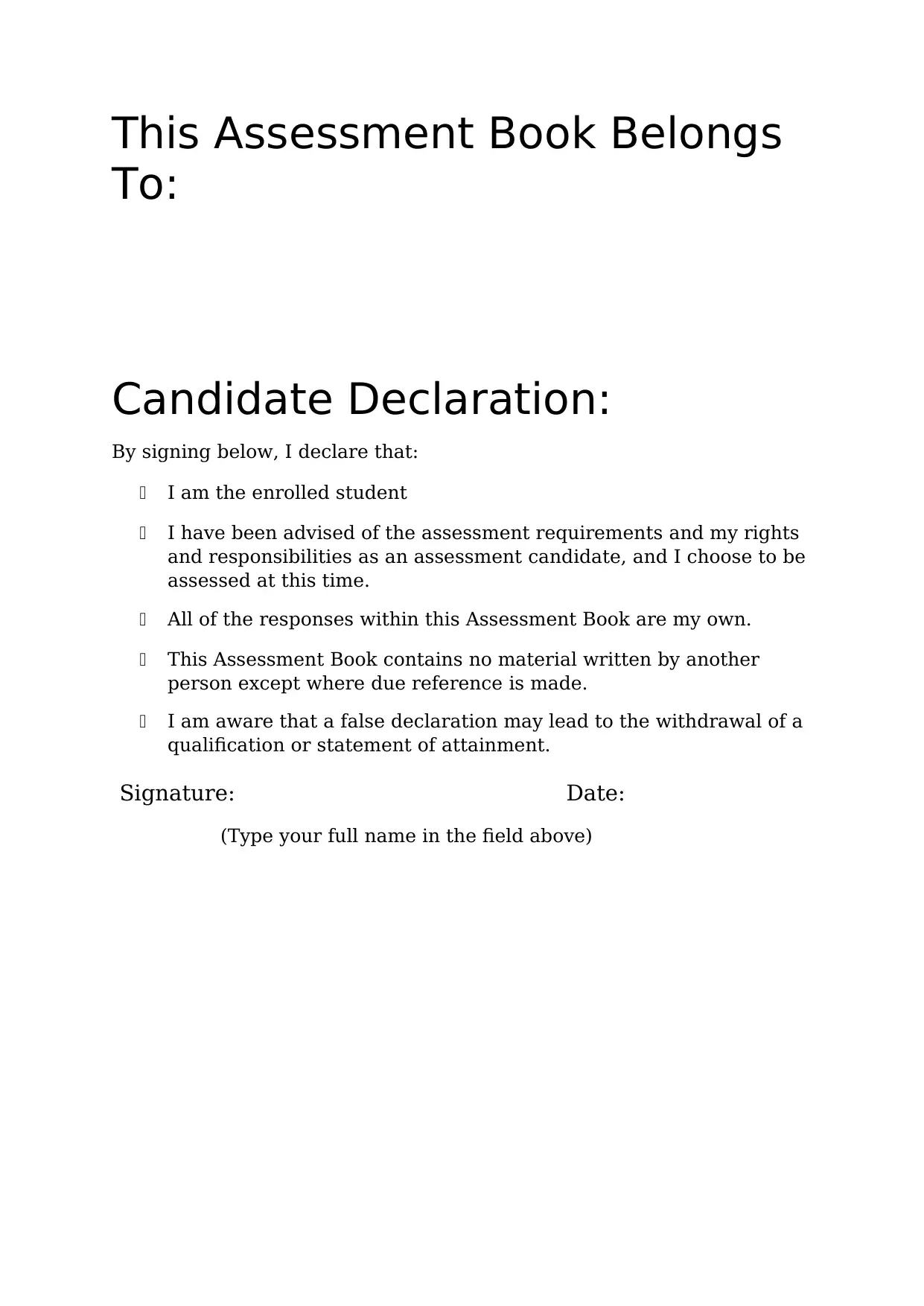
This Assessment Book Belongs
To:
Candidate Declaration:
By signing below, I declare that:
I am the enrolled student
I have been advised of the assessment requirements and my rights
and responsibilities as an assessment candidate, and I choose to be
assessed at this time.
All of the responses within this Assessment Book are my own.
This Assessment Book contains no material written by another
person except where due reference is made.
I am aware that a false declaration may lead to the withdrawal of a
qualification or statement of attainment.
Signature: Date:
(Type your full name in the field above)
To:
Candidate Declaration:
By signing below, I declare that:
I am the enrolled student
I have been advised of the assessment requirements and my rights
and responsibilities as an assessment candidate, and I choose to be
assessed at this time.
All of the responses within this Assessment Book are my own.
This Assessment Book contains no material written by another
person except where due reference is made.
I am aware that a false declaration may lead to the withdrawal of a
qualification or statement of attainment.
Signature: Date:
(Type your full name in the field above)

4

Assessment Summary
Please find below the results of your first submission (this will be
completed by your assessor after your Assessment Book has been
submitted)
Result Date Assessed Assessor Name
Assessor
Initials
Questions to resubmit (if first submission is not yet competent)
Students, please note:
A Not Yet Competent (NYC) result does not mean that you have
to redo the whole unit. In the box above, the marker has
identified exactly which questions you need to resubmit.
Feedback is provided (in a comment box) beside your current
answer. All resubmissions have to be completed at the end of
this marked book.
To make a resubmission,
Step 1: Go right to the end of this Assessment Book to the
“Resubmission Page”. Please do not change your original answers.
Your marker will need to look at your original answer and your
resubmitted answer.
Step 2: Write the question number and then enter your answers into the
Resubmission Box.
The box will expand as you enter text.
Step 3: Make sure that you have answered all of the questions that
you have been asked to resubmit.
Step 4: Resubmit this assessment book for marking via the student
portal.
All the best!
Please find below the results of your resubmission (this will be
completed by your assessor after your Assessment Book has been
resubmitted)
Resubmission
Date Assessed Assessor Name
Assessor
Initials
Result
Please find below the results of your first submission (this will be
completed by your assessor after your Assessment Book has been
submitted)
Result Date Assessed Assessor Name
Assessor
Initials
Questions to resubmit (if first submission is not yet competent)
Students, please note:
A Not Yet Competent (NYC) result does not mean that you have
to redo the whole unit. In the box above, the marker has
identified exactly which questions you need to resubmit.
Feedback is provided (in a comment box) beside your current
answer. All resubmissions have to be completed at the end of
this marked book.
To make a resubmission,
Step 1: Go right to the end of this Assessment Book to the
“Resubmission Page”. Please do not change your original answers.
Your marker will need to look at your original answer and your
resubmitted answer.
Step 2: Write the question number and then enter your answers into the
Resubmission Box.
The box will expand as you enter text.
Step 3: Make sure that you have answered all of the questions that
you have been asked to resubmit.
Step 4: Resubmit this assessment book for marking via the student
portal.
All the best!
Please find below the results of your resubmission (this will be
completed by your assessor after your Assessment Book has been
resubmitted)
Resubmission
Date Assessed Assessor Name
Assessor
Initials
Result
Paraphrase This Document
Need a fresh take? Get an instant paraphrase of this document with our AI Paraphraser
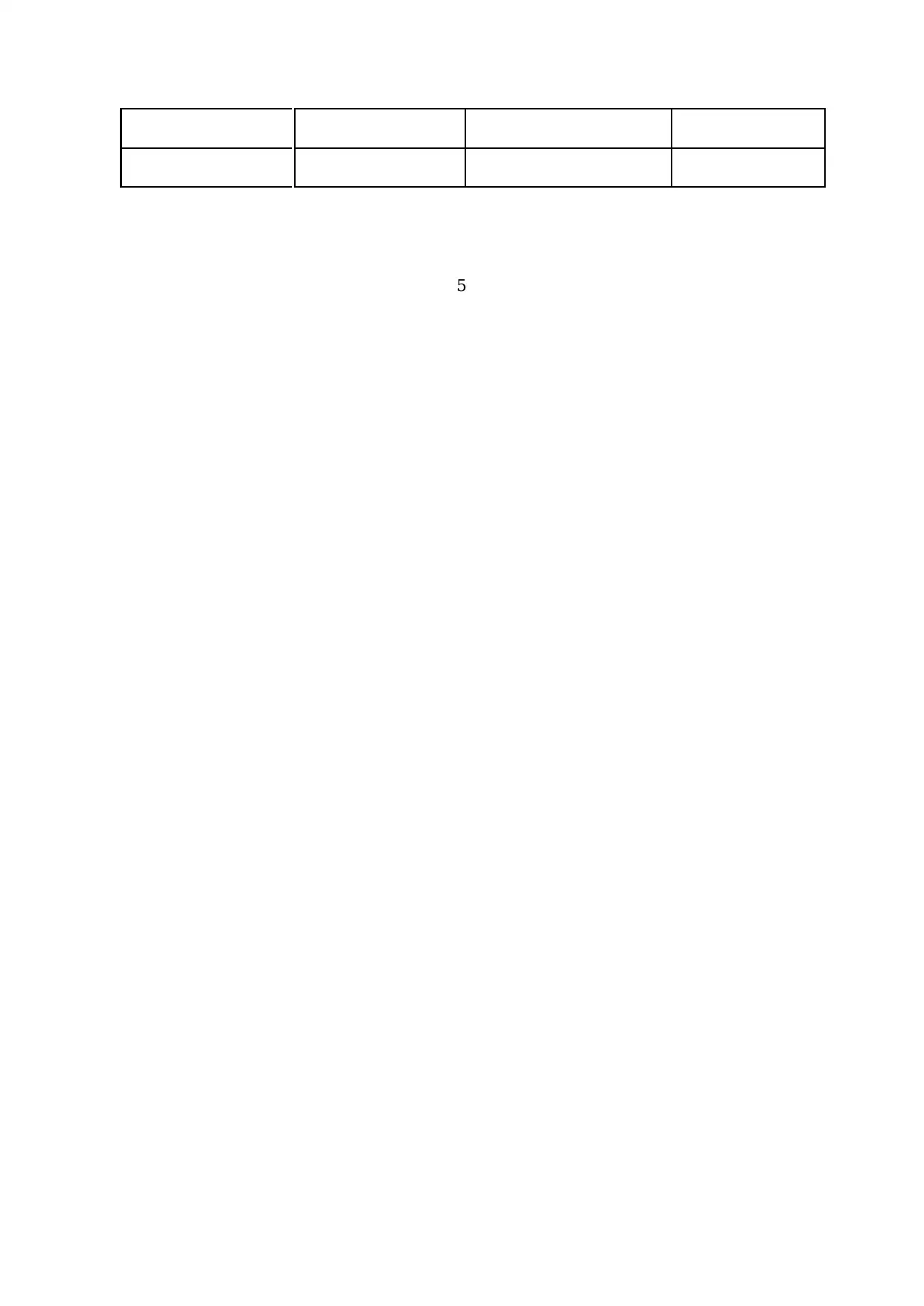
5

Section 1
AN INTRODUCTION TO KEY
COUNSELLING APPROACHES
Historical development of counselling approaches
1.1 Consider what you learned about the historical development of
major counselling theories in relation to the diagram below.
Which of the following options correctly labels the above diagram?
a) A = Person-Centred Therapy; B = Behaviour Therapy; C =
Cognitive Therapy; D
= Cognitive-Behavioural Therapy; E = Narrative Therapy; F =
Acceptance and Commitment Therapy; G = Solution-Focused
Therapy
b) A = Behaviour Therapy; B = Person-Centred Therapy; C =
Cognitive Therapy; D
= Solution-Focused Therapy; E = Cognitive-Behavioural
Therapy; F = Narrative Therapy; G = Acceptance and
Commitment Therapy
c) A = Behaviour Therapy; B = Cognitive Therapy; C =
Cognitive-Behavioural Therapy; D = Person-Centred Therapy;
E = Solution-Focused Therapy; F = Acceptance and
Commitment Therapy; G = Narrative Therapy
Your response = b
Cognitive and behaviour therapies
1.2 Select whether the following statements are True or False.
a) Counselling based upon cognitive and behavioural principles
have evolved in three ‘waves’ over the course of the 20th
century.
True ✓ False
AN INTRODUCTION TO KEY
COUNSELLING APPROACHES
Historical development of counselling approaches
1.1 Consider what you learned about the historical development of
major counselling theories in relation to the diagram below.
Which of the following options correctly labels the above diagram?
a) A = Person-Centred Therapy; B = Behaviour Therapy; C =
Cognitive Therapy; D
= Cognitive-Behavioural Therapy; E = Narrative Therapy; F =
Acceptance and Commitment Therapy; G = Solution-Focused
Therapy
b) A = Behaviour Therapy; B = Person-Centred Therapy; C =
Cognitive Therapy; D
= Solution-Focused Therapy; E = Cognitive-Behavioural
Therapy; F = Narrative Therapy; G = Acceptance and
Commitment Therapy
c) A = Behaviour Therapy; B = Cognitive Therapy; C =
Cognitive-Behavioural Therapy; D = Person-Centred Therapy;
E = Solution-Focused Therapy; F = Acceptance and
Commitment Therapy; G = Narrative Therapy
Your response = b
Cognitive and behaviour therapies
1.2 Select whether the following statements are True or False.
a) Counselling based upon cognitive and behavioural principles
have evolved in three ‘waves’ over the course of the 20th
century.
True ✓ False
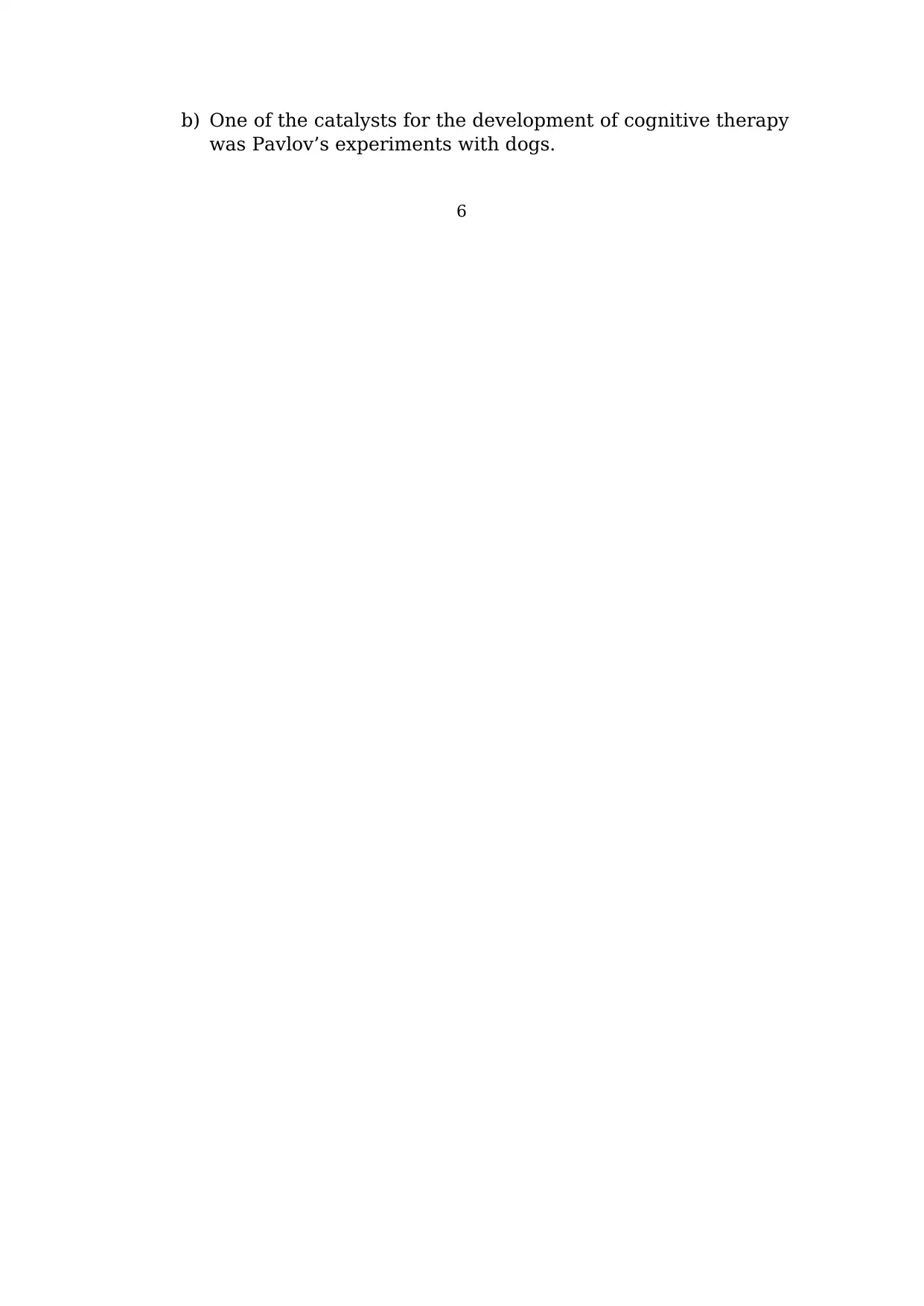
b) One of the catalysts for the development of cognitive therapy
was Pavlov’s experiments with dogs.
6
was Pavlov’s experiments with dogs.
6
Secure Best Marks with AI Grader
Need help grading? Try our AI Grader for instant feedback on your assignments.

True ✓ False
c) Behaviour therapy utilises learning theory to modify
behaviours by observing associations between observable
events and responses.
True ✓ False
d) One of the proponents of cognitive therapy was Dr Aaron T.
Beck.
True ✓ False
e) The cognitive therapy model suggests that psychological
issues are caused through stimulus and response
relationships.
True False ✓
f) In cognitive therapy, the focus is on the role that thoughts
and beliefs play in emotional and behavioural responses.
True ✓ False
g) Cognitive behavioural therapy came to prominence in the 1970’s.
True ✓ False
h) Cognitive behavioural therapy is considered to represent the
‘second wave’ of behavioural therapy.
True ✓ False
i) Acceptance and commitment therapy is an example of a ‘third
wave’ approach of behavioural therapy.
True ✓ False
j) Acceptance and commitment therapy focuses on helping
clients understand their childhood experiences and how these
experiences impact their adult lives.
True ✓ False
Humanistic approaches
1.3 The humanistic perspective and person-centred counselling was
developed in the 1950s as an alternative to which two popular
perspectives at the time? (Your response should be no more than
5 words)
psychodynamic and behaviorism
c) Behaviour therapy utilises learning theory to modify
behaviours by observing associations between observable
events and responses.
True ✓ False
d) One of the proponents of cognitive therapy was Dr Aaron T.
Beck.
True ✓ False
e) The cognitive therapy model suggests that psychological
issues are caused through stimulus and response
relationships.
True False ✓
f) In cognitive therapy, the focus is on the role that thoughts
and beliefs play in emotional and behavioural responses.
True ✓ False
g) Cognitive behavioural therapy came to prominence in the 1970’s.
True ✓ False
h) Cognitive behavioural therapy is considered to represent the
‘second wave’ of behavioural therapy.
True ✓ False
i) Acceptance and commitment therapy is an example of a ‘third
wave’ approach of behavioural therapy.
True ✓ False
j) Acceptance and commitment therapy focuses on helping
clients understand their childhood experiences and how these
experiences impact their adult lives.
True ✓ False
Humanistic approaches
1.3 The humanistic perspective and person-centred counselling was
developed in the 1950s as an alternative to which two popular
perspectives at the time? (Your response should be no more than
5 words)
psychodynamic and behaviorism
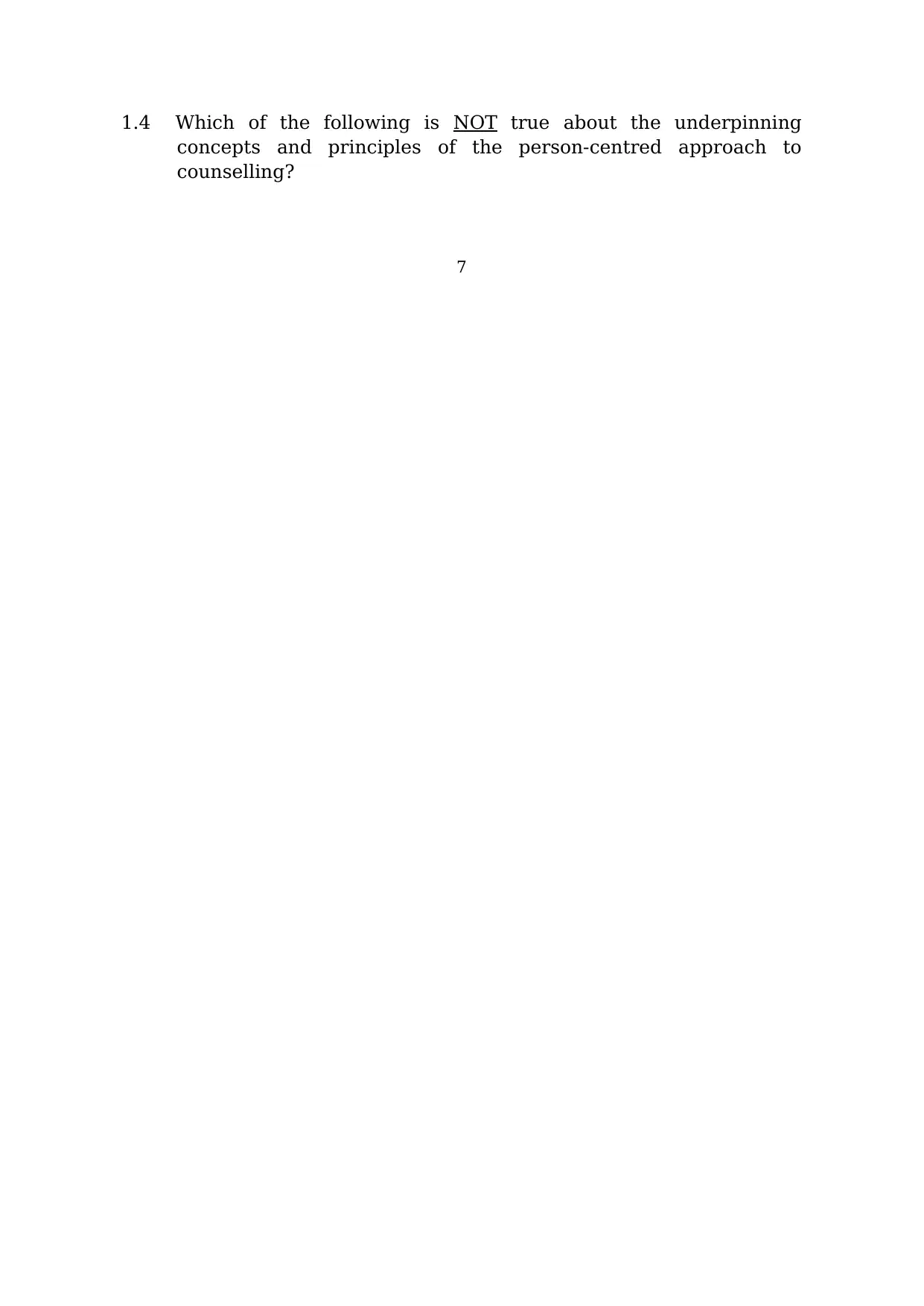
1.4 Which of the following is NOT true about the underpinning
concepts and principles of the person-centred approach to
counselling?
7
concepts and principles of the person-centred approach to
counselling?
7
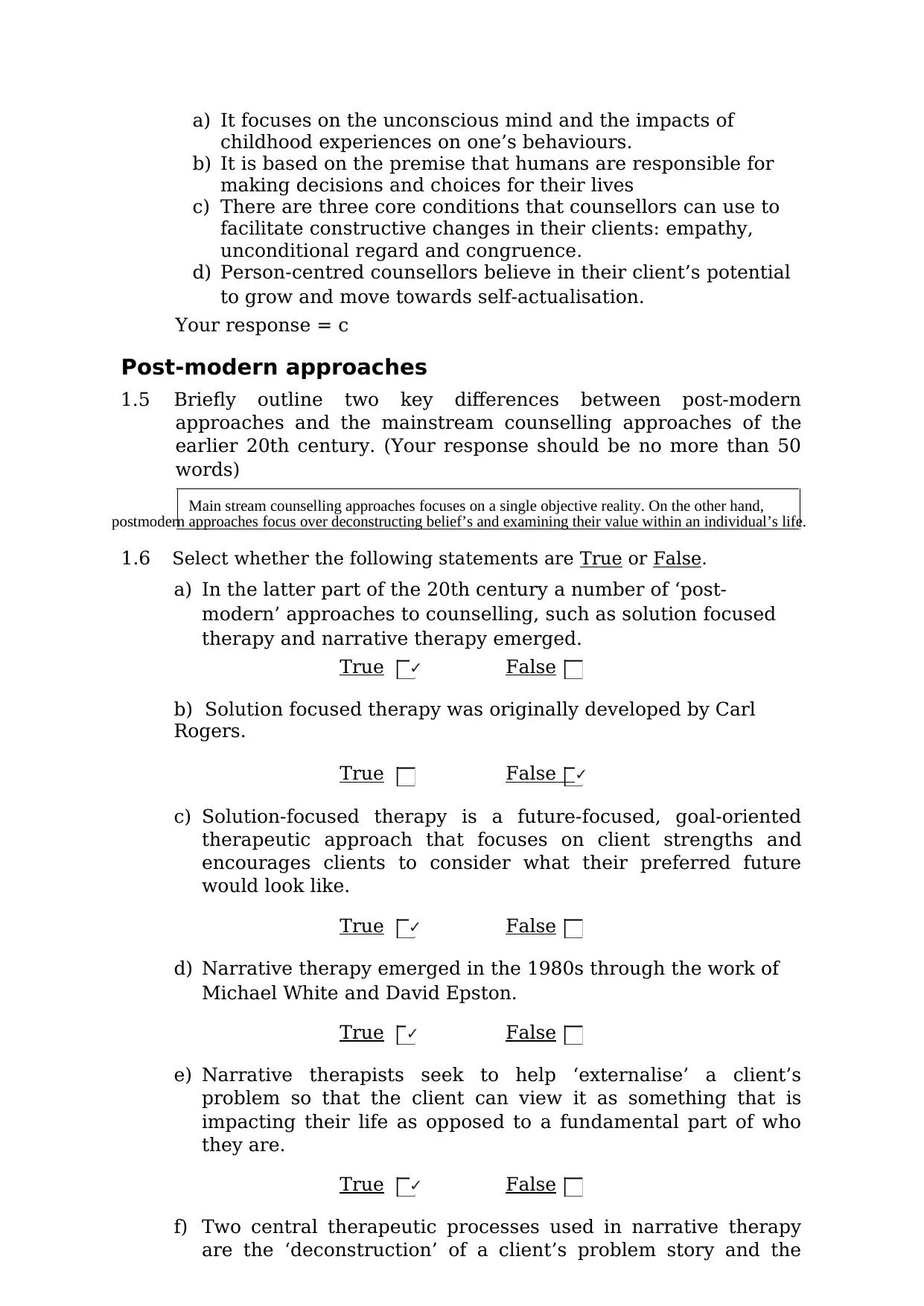
a) It focuses on the unconscious mind and the impacts of
childhood experiences on one’s behaviours.
b) It is based on the premise that humans are responsible for
making decisions and choices for their lives
c) There are three core conditions that counsellors can use to
facilitate constructive changes in their clients: empathy,
unconditional regard and congruence.
d) Person-centred counsellors believe in their client’s potential
to grow and move towards self-actualisation.
Your response = c
Post-modern approaches
1.5 Briefly outline two key differences between post-modern
approaches and the mainstream counselling approaches of the
earlier 20th century. (Your response should be no more than 50
words)
Main stream counselling approaches focuses on a single objective reality. On the other hand,
postmodern approaches focus over deconstructing belief’s and examining their value within an individual’s life.
1.6 Select whether the following statements are True or False.
a) In the latter part of the 20th century a number of ‘post-
modern’ approaches to counselling, such as solution focused
therapy and narrative therapy emerged.
True ✓ False
b) Solution focused therapy was originally developed by Carl
Rogers.
True False ✓
c) Solution-focused therapy is a future-focused, goal-oriented
therapeutic approach that focuses on client strengths and
encourages clients to consider what their preferred future
would look like.
True ✓ False
d) Narrative therapy emerged in the 1980s through the work of
Michael White and David Epston.
True ✓ False
e) Narrative therapists seek to help ‘externalise’ a client’s
problem so that the client can view it as something that is
impacting their life as opposed to a fundamental part of who
they are.
True ✓ False
f) Two central therapeutic processes used in narrative therapy
are the ‘deconstruction’ of a client’s problem story and the
childhood experiences on one’s behaviours.
b) It is based on the premise that humans are responsible for
making decisions and choices for their lives
c) There are three core conditions that counsellors can use to
facilitate constructive changes in their clients: empathy,
unconditional regard and congruence.
d) Person-centred counsellors believe in their client’s potential
to grow and move towards self-actualisation.
Your response = c
Post-modern approaches
1.5 Briefly outline two key differences between post-modern
approaches and the mainstream counselling approaches of the
earlier 20th century. (Your response should be no more than 50
words)
Main stream counselling approaches focuses on a single objective reality. On the other hand,
postmodern approaches focus over deconstructing belief’s and examining their value within an individual’s life.
1.6 Select whether the following statements are True or False.
a) In the latter part of the 20th century a number of ‘post-
modern’ approaches to counselling, such as solution focused
therapy and narrative therapy emerged.
True ✓ False
b) Solution focused therapy was originally developed by Carl
Rogers.
True False ✓
c) Solution-focused therapy is a future-focused, goal-oriented
therapeutic approach that focuses on client strengths and
encourages clients to consider what their preferred future
would look like.
True ✓ False
d) Narrative therapy emerged in the 1980s through the work of
Michael White and David Epston.
True ✓ False
e) Narrative therapists seek to help ‘externalise’ a client’s
problem so that the client can view it as something that is
impacting their life as opposed to a fundamental part of who
they are.
True ✓ False
f) Two central therapeutic processes used in narrative therapy
are the ‘deconstruction’ of a client’s problem story and the
Paraphrase This Document
Need a fresh take? Get an instant paraphrase of this document with our AI Paraphraser
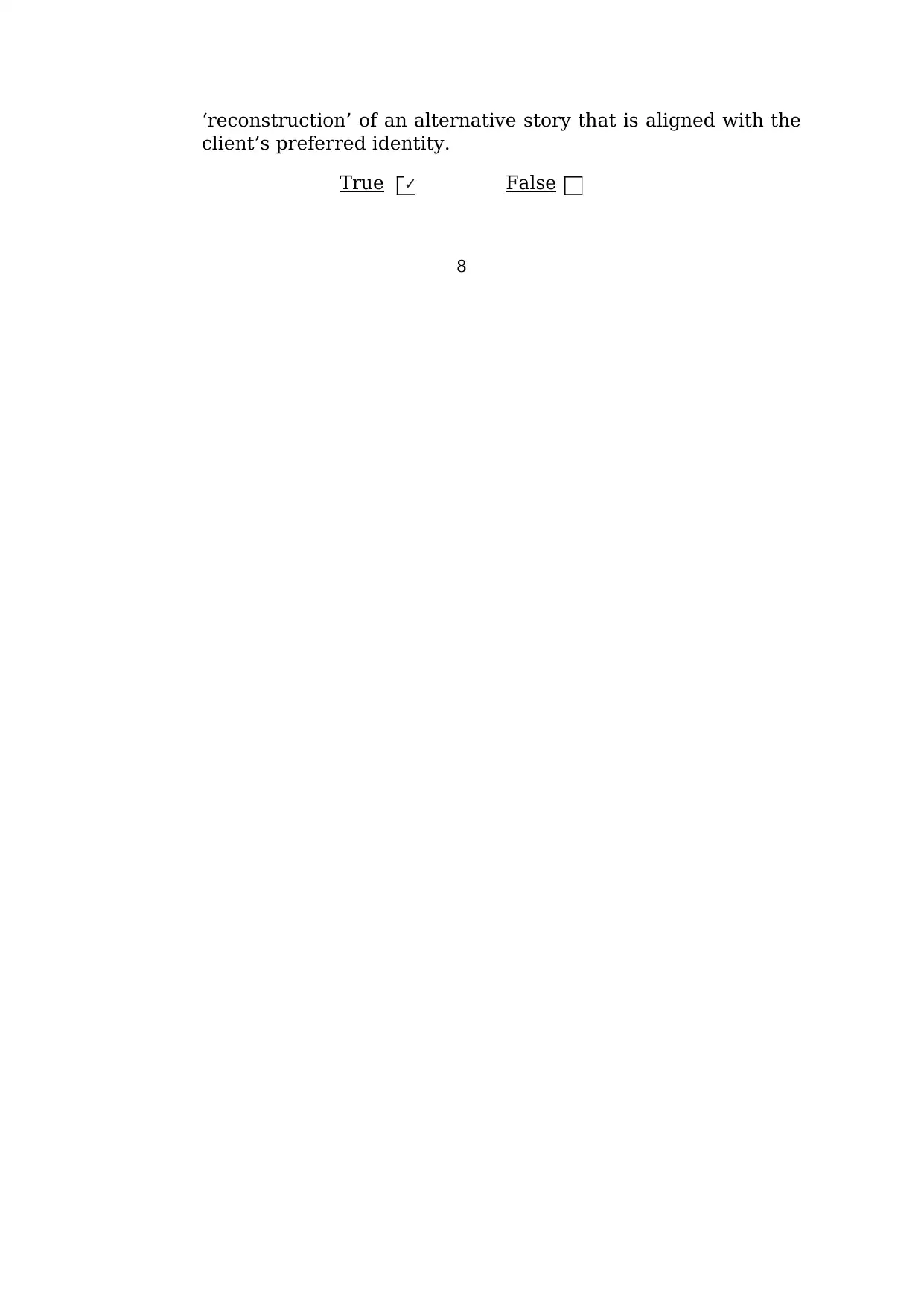
‘reconstruction’ of an alternative story that is aligned with the
client’s preferred identity.
True ✓ False
8
client’s preferred identity.
True ✓ False
8
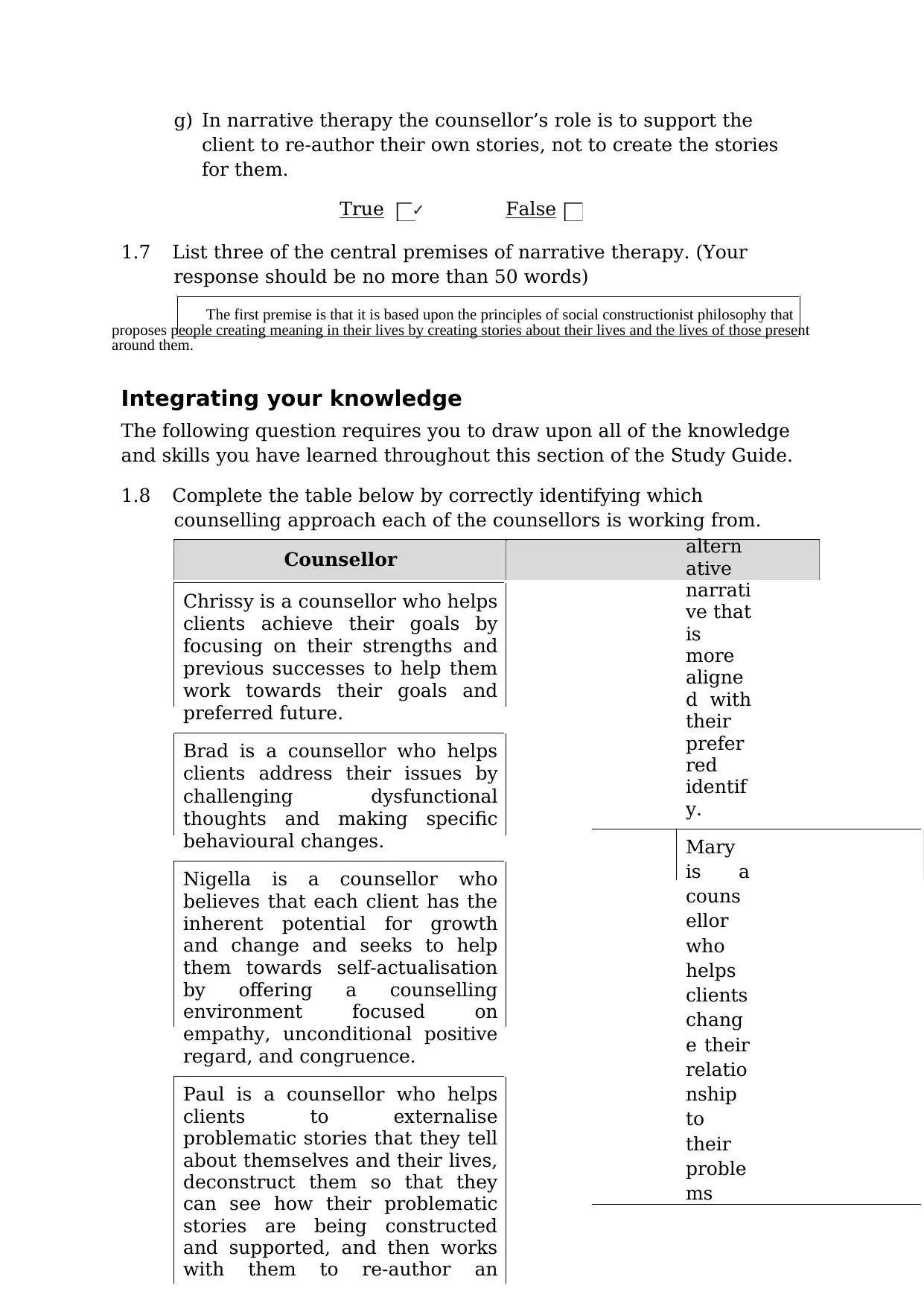
g) In narrative therapy the counsellor’s role is to support the
client to re-author their own stories, not to create the stories
for them.
True ✓ False
1.7 List three of the central premises of narrative therapy. (Your
response should be no more than 50 words)
The first premise is that it is based upon the principles of social constructionist philosophy that
proposes people creating meaning in their lives by creating stories about their lives and the lives of those present
around them.
Integrating your knowledge
The following question requires you to draw upon all of the knowledge
and skills you have learned throughout this section of the Study Guide.
1.8 Complete the table below by correctly identifying which
counselling approach each of the counsellors is working from.
Counsellor
Chrissy is a counsellor who helps
clients achieve their goals by
focusing on their strengths and
previous successes to help them
work towards their goals and
preferred future.
Brad is a counsellor who helps
clients address their issues by
challenging dysfunctional
thoughts and making specific
behavioural changes.
Nigella is a counsellor who
believes that each client has the
inherent potential for growth
and change and seeks to help
them towards self-actualisation
by offering a counselling
environment focused on
empathy, unconditional positive
regard, and congruence.
Paul is a counsellor who helps
clients to externalise
problematic stories that they tell
about themselves and their lives,
deconstruct them so that they
can see how their problematic
stories are being constructed
and supported, and then works
with them to re-author an
altern
ative
narrati
ve that
is
more
aligne
d with
their
prefer
red
identif
y.
Mary
is a
couns
ellor
who
helps
clients
chang
e their
relatio
nship
to
their
proble
ms
client to re-author their own stories, not to create the stories
for them.
True ✓ False
1.7 List three of the central premises of narrative therapy. (Your
response should be no more than 50 words)
The first premise is that it is based upon the principles of social constructionist philosophy that
proposes people creating meaning in their lives by creating stories about their lives and the lives of those present
around them.
Integrating your knowledge
The following question requires you to draw upon all of the knowledge
and skills you have learned throughout this section of the Study Guide.
1.8 Complete the table below by correctly identifying which
counselling approach each of the counsellors is working from.
Counsellor
Chrissy is a counsellor who helps
clients achieve their goals by
focusing on their strengths and
previous successes to help them
work towards their goals and
preferred future.
Brad is a counsellor who helps
clients address their issues by
challenging dysfunctional
thoughts and making specific
behavioural changes.
Nigella is a counsellor who
believes that each client has the
inherent potential for growth
and change and seeks to help
them towards self-actualisation
by offering a counselling
environment focused on
empathy, unconditional positive
regard, and congruence.
Paul is a counsellor who helps
clients to externalise
problematic stories that they tell
about themselves and their lives,
deconstruct them so that they
can see how their problematic
stories are being constructed
and supported, and then works
with them to re-author an
altern
ative
narrati
ve that
is
more
aligne
d with
their
prefer
red
identif
y.
Mary
is a
couns
ellor
who
helps
clients
chang
e their
relatio
nship
to
their
proble
ms

Approach
Solution focused therapy
Cognitive therapy
Person centered
approach
Narrative therapy
9
Solution focused therapy
Cognitive therapy
Person centered
approach
Narrative therapy
9
Secure Best Marks with AI Grader
Need help grading? Try our AI Grader for instant feedback on your assignments.

by promoting an acceptance of here-and-
now experiences and engaging in
Acceptance and Commitment therapy
experiential exercises.
10
now experiences and engaging in
Acceptance and Commitment therapy
experiential exercises.
10
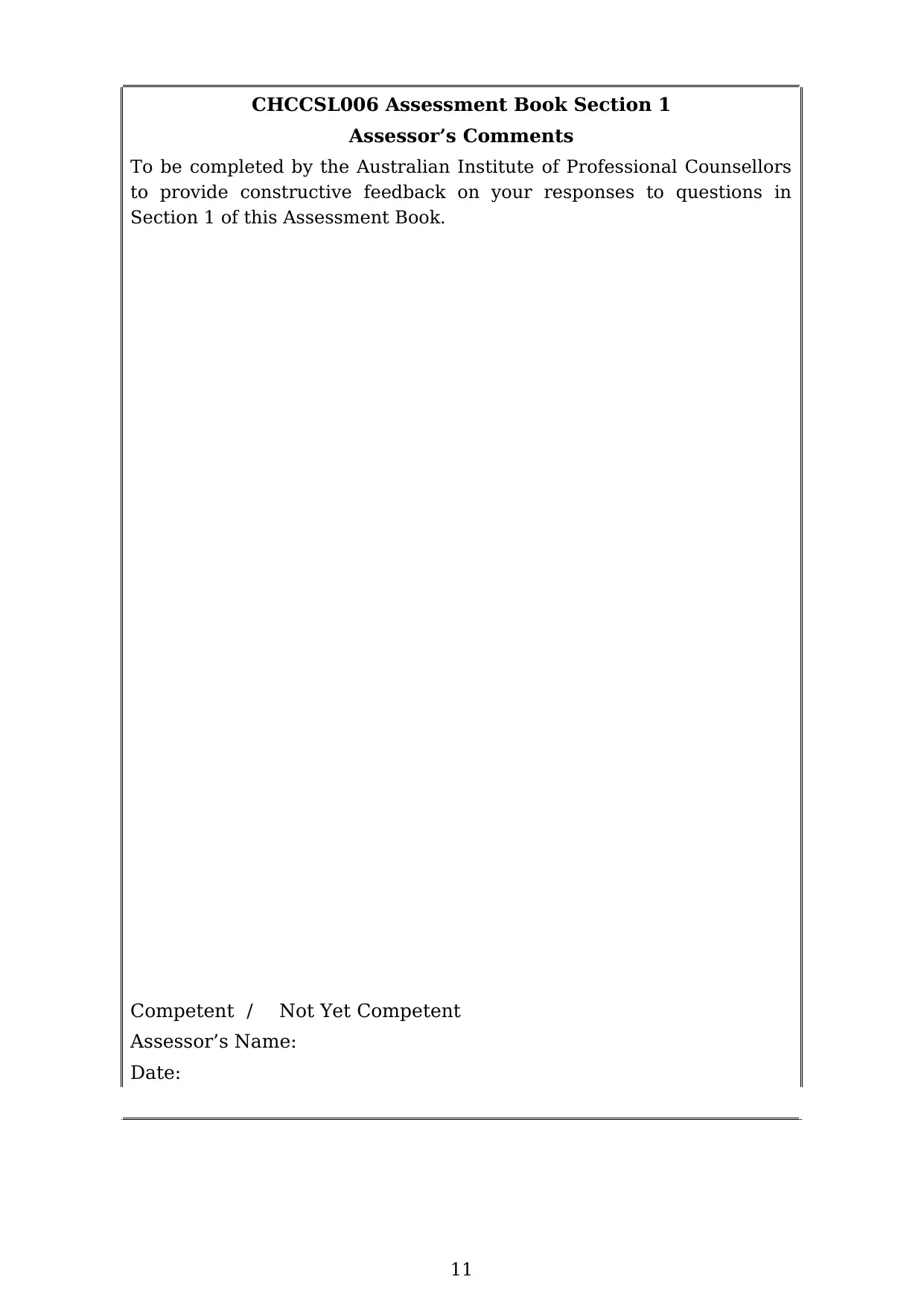
CHCCSL006 Assessment Book Section 1
Assessor’s Comments
To be completed by the Australian Institute of Professional Counsellors
to provide constructive feedback on your responses to questions in
Section 1 of this Assessment Book.
Competent / Not Yet Competent
Assessor’s Name:
Date:
11
Assessor’s Comments
To be completed by the Australian Institute of Professional Counsellors
to provide constructive feedback on your responses to questions in
Section 1 of this Assessment Book.
Competent / Not Yet Competent
Assessor’s Name:
Date:
11
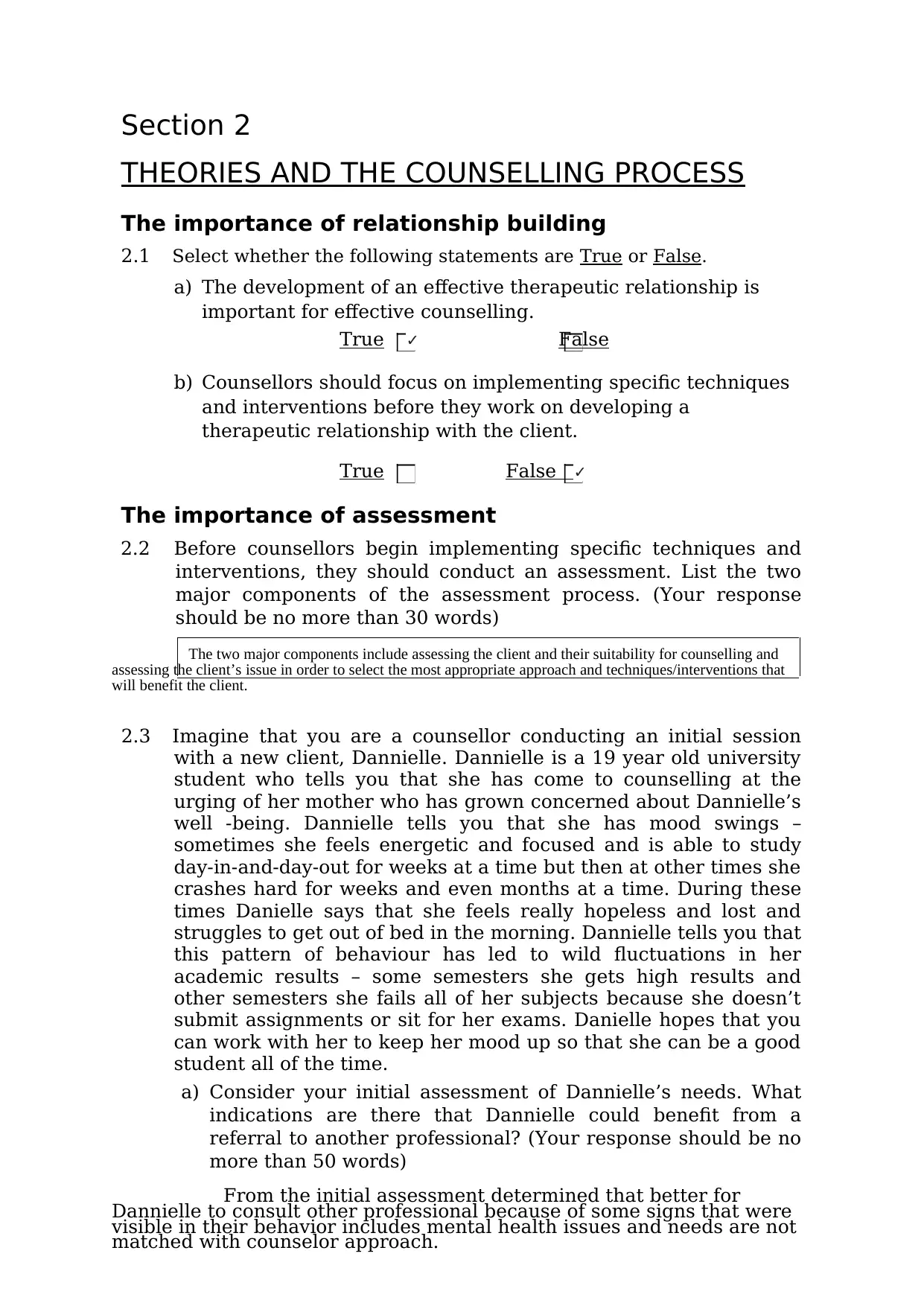
Section 2
THEORIES AND THE COUNSELLING PROCESS
The importance of relationship building
2.1 Select whether the following statements are True or False.
a) The development of an effective therapeutic relationship is
important for effective counselling.
True ✓ False
b) Counsellors should focus on implementing specific techniques
and interventions before they work on developing a
therapeutic relationship with the client.
True False ✓
The importance of assessment
2.2 Before counsellors begin implementing specific techniques and
interventions, they should conduct an assessment. List the two
major components of the assessment process. (Your response
should be no more than 30 words)
The two major components include assessing the client and their suitability for counselling and
assessing the client’s issue in order to select the most appropriate approach and techniques/interventions that
will benefit the client.
2.3 Imagine that you are a counsellor conducting an initial session
with a new client, Dannielle. Dannielle is a 19 year old university
student who tells you that she has come to counselling at the
urging of her mother who has grown concerned about Dannielle’s
well -being. Dannielle tells you that she has mood swings –
sometimes she feels energetic and focused and is able to study
day-in-and-day-out for weeks at a time but then at other times she
crashes hard for weeks and even months at a time. During these
times Danielle says that she feels really hopeless and lost and
struggles to get out of bed in the morning. Dannielle tells you that
this pattern of behaviour has led to wild fluctuations in her
academic results – some semesters she gets high results and
other semesters she fails all of her subjects because she doesn’t
submit assignments or sit for her exams. Danielle hopes that you
can work with her to keep her mood up so that she can be a good
student all of the time.
a) Consider your initial assessment of Dannielle’s needs. What
indications are there that Dannielle could benefit from a
referral to another professional? (Your response should be no
more than 50 words)
From the initial assessment determined that better for
Dannielle to consult other professional because of some signs that were
visible in their behavior includes mental health issues and needs are not
matched with counselor approach.
THEORIES AND THE COUNSELLING PROCESS
The importance of relationship building
2.1 Select whether the following statements are True or False.
a) The development of an effective therapeutic relationship is
important for effective counselling.
True ✓ False
b) Counsellors should focus on implementing specific techniques
and interventions before they work on developing a
therapeutic relationship with the client.
True False ✓
The importance of assessment
2.2 Before counsellors begin implementing specific techniques and
interventions, they should conduct an assessment. List the two
major components of the assessment process. (Your response
should be no more than 30 words)
The two major components include assessing the client and their suitability for counselling and
assessing the client’s issue in order to select the most appropriate approach and techniques/interventions that
will benefit the client.
2.3 Imagine that you are a counsellor conducting an initial session
with a new client, Dannielle. Dannielle is a 19 year old university
student who tells you that she has come to counselling at the
urging of her mother who has grown concerned about Dannielle’s
well -being. Dannielle tells you that she has mood swings –
sometimes she feels energetic and focused and is able to study
day-in-and-day-out for weeks at a time but then at other times she
crashes hard for weeks and even months at a time. During these
times Danielle says that she feels really hopeless and lost and
struggles to get out of bed in the morning. Dannielle tells you that
this pattern of behaviour has led to wild fluctuations in her
academic results – some semesters she gets high results and
other semesters she fails all of her subjects because she doesn’t
submit assignments or sit for her exams. Danielle hopes that you
can work with her to keep her mood up so that she can be a good
student all of the time.
a) Consider your initial assessment of Dannielle’s needs. What
indications are there that Dannielle could benefit from a
referral to another professional? (Your response should be no
more than 50 words)
From the initial assessment determined that better for
Dannielle to consult other professional because of some signs that were
visible in their behavior includes mental health issues and needs are not
matched with counselor approach.
Paraphrase This Document
Need a fresh take? Get an instant paraphrase of this document with our AI Paraphraser

b) Imagine that you have discussed referral with Dannielle and
she has agreed. In order to make a referral your organisation
requires you to complete a referral from. Complete the blank
fields in the referral form below to make a referral for
Dannielle.
Referral for Services
12
she has agreed. In order to make a referral your organisation
requires you to complete a referral from. Complete the blank
fields in the referral form below to make a referral for
Dannielle.
Referral for Services
12

Date
Client’s Full
Name
Address
Phone
Number
Reason for
Referral
12/04/201X
Dannielle Norman
123 High St, Maintown
98 76543 211
The reason for referral are mental health issues and needs of person that not
suited to approach of counselor.
Is client currently in
crisis? Yes
✓ No
Referral
Completed by:
Counsel
or
Organisation: Brightside Counselling Service
Address: 987 Main St, Maintown
Phone
:
98 12345
678 Fax
98 12345
699
2.4 Imagine that you are conducting an initial counselling session
with Jennifer, a 36 year-old woman who has sought counselling
for assistance with issues of stress and binge eating. After the
initial assessment, you have no concerns regarding her suitability
for counselling.
You want to gather information about Jennifer in order to determine
the most appropriate approach and techniques/interventions for
working with her. List five types of information that you would
gather to help gain a fuller understanding of Jennifer and her
issues/needs/goals. (Your response should be no more than 75
words)
The list of five types of information that will help the counselor to understand Jennifer and her
issues/needs and goals is presented below:
Ascertaining background information about client including personal, family and personal history.
Ascertaining information about current life context
Ascertaining information about client functioning including behavioral indicators
Determine information about client conceptualization of the issue
Ascertaining information about client goals
Determining the information about aspects that motivates and creates barrier to bring change
A note on eclecticism and integration
2.5 Why might a counsellor practice eclecticism and/or integration in
their work? (Your response should be no more than 50 words)
Client’s Full
Name
Address
Phone
Number
Reason for
Referral
12/04/201X
Dannielle Norman
123 High St, Maintown
98 76543 211
The reason for referral are mental health issues and needs of person that not
suited to approach of counselor.
Is client currently in
crisis? Yes
✓ No
Referral
Completed by:
Counsel
or
Organisation: Brightside Counselling Service
Address: 987 Main St, Maintown
Phone
:
98 12345
678 Fax
98 12345
699
2.4 Imagine that you are conducting an initial counselling session
with Jennifer, a 36 year-old woman who has sought counselling
for assistance with issues of stress and binge eating. After the
initial assessment, you have no concerns regarding her suitability
for counselling.
You want to gather information about Jennifer in order to determine
the most appropriate approach and techniques/interventions for
working with her. List five types of information that you would
gather to help gain a fuller understanding of Jennifer and her
issues/needs/goals. (Your response should be no more than 75
words)
The list of five types of information that will help the counselor to understand Jennifer and her
issues/needs and goals is presented below:
Ascertaining background information about client including personal, family and personal history.
Ascertaining information about current life context
Ascertaining information about client functioning including behavioral indicators
Determine information about client conceptualization of the issue
Ascertaining information about client goals
Determining the information about aspects that motivates and creates barrier to bring change
A note on eclecticism and integration
2.5 Why might a counsellor practice eclecticism and/or integration in
their work? (Your response should be no more than 50 words)

Eclecticism. The word eclectic means originating things from various bases. Functional to analysis this refers to
merging diverse, but harmonizing, therapy approaches that have been occupied from diverse representations of
rehabilitation.
Integration: This includes combining one thing with another to form a whole new.
2.6 Select whether the following statements are True or False.
a) A counsellor working from an eclectic approach would select
counselling techniques from a variety of therapies based upon
their usefulness in meeting a client’s needs.
True ✓ False
b) When practicing from an integrated approach, it is important
to ensure the techniques selected are complementary with
each other.
13
merging diverse, but harmonizing, therapy approaches that have been occupied from diverse representations of
rehabilitation.
Integration: This includes combining one thing with another to form a whole new.
2.6 Select whether the following statements are True or False.
a) A counsellor working from an eclectic approach would select
counselling techniques from a variety of therapies based upon
their usefulness in meeting a client’s needs.
True ✓ False
b) When practicing from an integrated approach, it is important
to ensure the techniques selected are complementary with
each other.
13
Secure Best Marks with AI Grader
Need help grading? Try our AI Grader for instant feedback on your assignments.
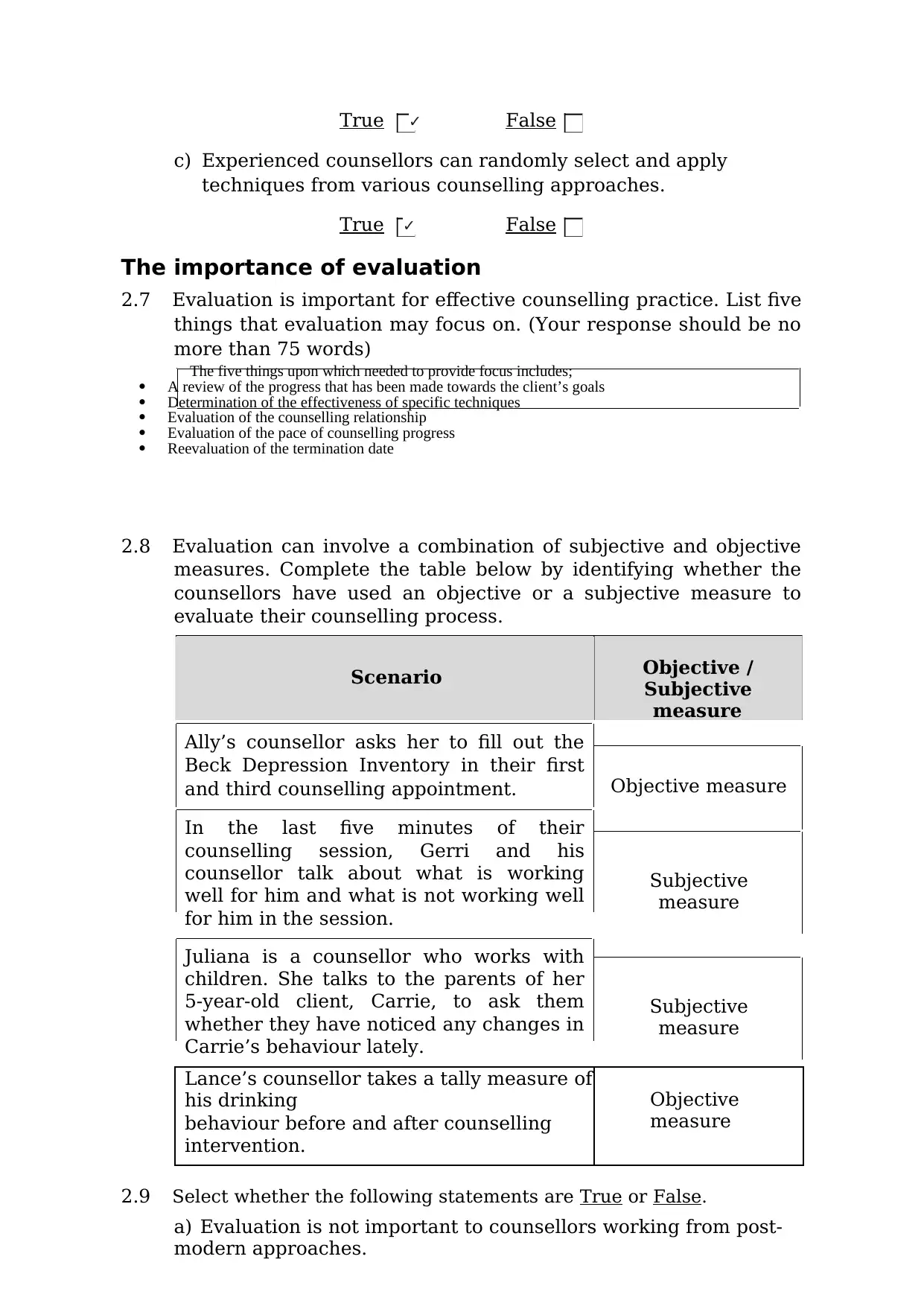
True ✓ False
c) Experienced counsellors can randomly select and apply
techniques from various counselling approaches.
True ✓ False
The importance of evaluation
2.7 Evaluation is important for effective counselling practice. List five
things that evaluation may focus on. (Your response should be no
more than 75 words)
The five things upon which needed to provide focus includes;
A review of the progress that has been made towards the client’s goals
Determination of the effectiveness of specific techniques
Evaluation of the counselling relationship
Evaluation of the pace of counselling progress
Reevaluation of the termination date
2.8 Evaluation can involve a combination of subjective and objective
measures. Complete the table below by identifying whether the
counsellors have used an objective or a subjective measure to
evaluate their counselling process.
Scenario
Ally’s counsellor asks her to fill out the
Beck Depression Inventory in their first
and third counselling appointment.
In the last five minutes of their
counselling session, Gerri and his
counsellor talk about what is working
well for him and what is not working well
for him in the session.
Juliana is a counsellor who works with
children. She talks to the parents of her
5-year-old client, Carrie, to ask them
whether they have noticed any changes in
Carrie’s behaviour lately.
Objective /
Subjective
measure
Objective measure
Subjective
measure
Subjective
measure
Lance’s counsellor takes a tally measure of
his drinking Objective
measurebehaviour before and after counselling
intervention.
2.9 Select whether the following statements are True or False.
a) Evaluation is not important to counsellors working from post-
modern approaches.
c) Experienced counsellors can randomly select and apply
techniques from various counselling approaches.
True ✓ False
The importance of evaluation
2.7 Evaluation is important for effective counselling practice. List five
things that evaluation may focus on. (Your response should be no
more than 75 words)
The five things upon which needed to provide focus includes;
A review of the progress that has been made towards the client’s goals
Determination of the effectiveness of specific techniques
Evaluation of the counselling relationship
Evaluation of the pace of counselling progress
Reevaluation of the termination date
2.8 Evaluation can involve a combination of subjective and objective
measures. Complete the table below by identifying whether the
counsellors have used an objective or a subjective measure to
evaluate their counselling process.
Scenario
Ally’s counsellor asks her to fill out the
Beck Depression Inventory in their first
and third counselling appointment.
In the last five minutes of their
counselling session, Gerri and his
counsellor talk about what is working
well for him and what is not working well
for him in the session.
Juliana is a counsellor who works with
children. She talks to the parents of her
5-year-old client, Carrie, to ask them
whether they have noticed any changes in
Carrie’s behaviour lately.
Objective /
Subjective
measure
Objective measure
Subjective
measure
Subjective
measure
Lance’s counsellor takes a tally measure of
his drinking Objective
measurebehaviour before and after counselling
intervention.
2.9 Select whether the following statements are True or False.
a) Evaluation is not important to counsellors working from post-
modern approaches.
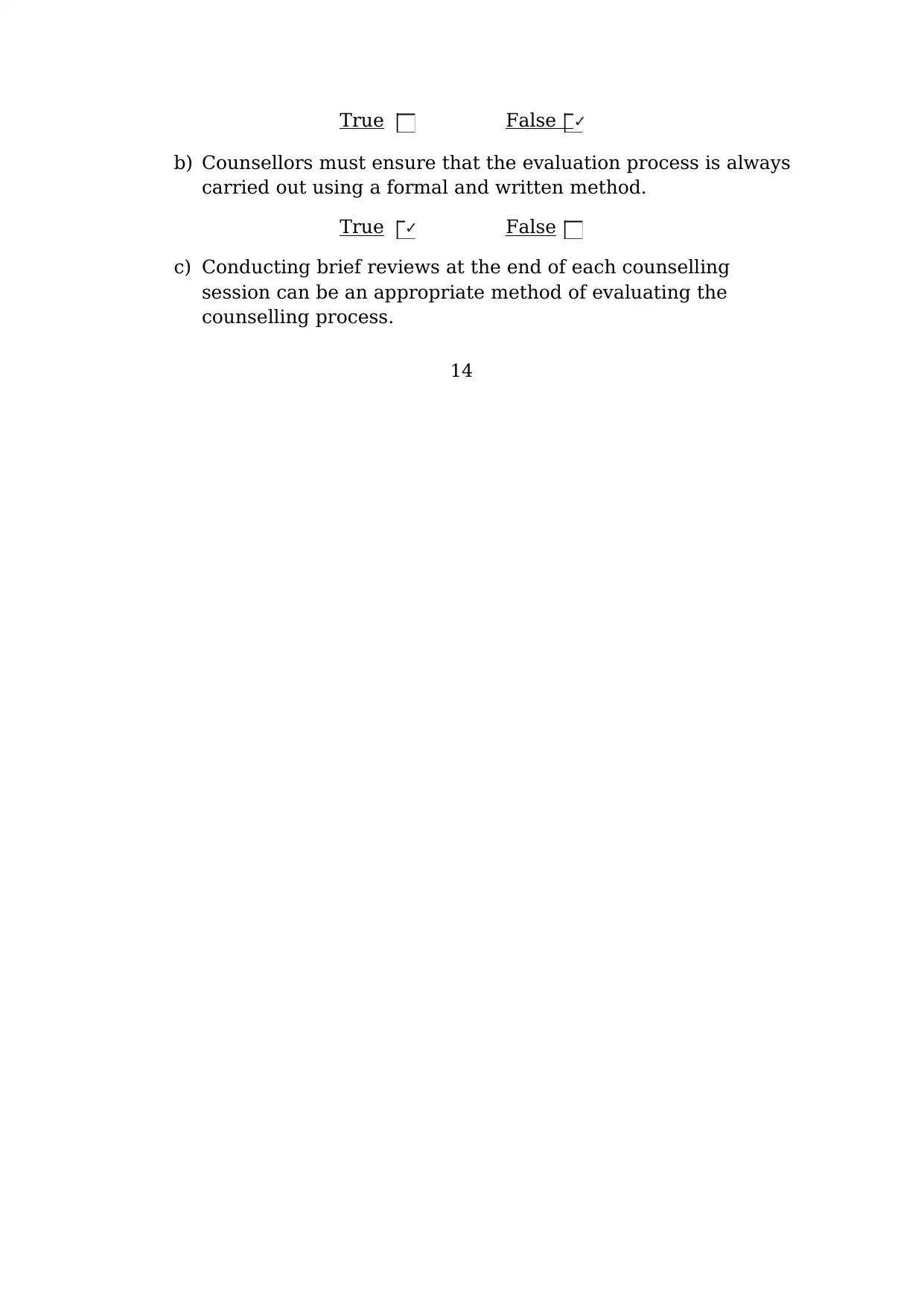
True False ✓
b) Counsellors must ensure that the evaluation process is always
carried out using a formal and written method.
True ✓ False
c) Conducting brief reviews at the end of each counselling
session can be an appropriate method of evaluating the
counselling process.
14
b) Counsellors must ensure that the evaluation process is always
carried out using a formal and written method.
True ✓ False
c) Conducting brief reviews at the end of each counselling
session can be an appropriate method of evaluating the
counselling process.
14

True ✓ False
d) Counsellors must comply with their organisation’s policies and
procedures for evaluation.
True ✓ False
The importance of ethical practice
2.10 Counsellors have a responsibility to comply with the legal and
ethical responsibilities of counselling practice. List three key
legal/ethical responsibilities that counsellors must comply with.
(Your response should be no more than 50 words)
Three ethical responsibilities which are must for counselor to comply with includes;
Codes of conduct and practice
Focus over fulfilment of human rights and discrimination
Effective fulfilment of the duty of care
Maintaining boundaries between practitioner and client
2.11 Select whether the following statements are True or False.
a) If a counsellor is unsure of how to handle a potential ethical
dilemma it would be appropriate to review the Australian
Counselling Association’s Code of Ethics and Practice for
guidance.
True ✓ False
b) Regardless of the counsellor’s theoretical approach, they must
ensure that all counselling practices respect the client’s
fundamental human rights.
True ✓ False
c) Counsellors must not treat a client differently, in a way that is
not helpful, based on a characteristic about them such as their
gender, age, race, disability, or sexual
preference.
True ✓ False
d) A counsellor’s duty of care only applies to clients who they
have been working with for more than three sessions.
True False ✓
e) It is appropriate for counsellors working from a person-
centred approach to engage in dual relationships with their
clients.
True False ✓
f) Counsellors must keep what a client tells them during sessions
completely private, even in cases when the client intends to
harm themselves.
True False ✓
d) Counsellors must comply with their organisation’s policies and
procedures for evaluation.
True ✓ False
The importance of ethical practice
2.10 Counsellors have a responsibility to comply with the legal and
ethical responsibilities of counselling practice. List three key
legal/ethical responsibilities that counsellors must comply with.
(Your response should be no more than 50 words)
Three ethical responsibilities which are must for counselor to comply with includes;
Codes of conduct and practice
Focus over fulfilment of human rights and discrimination
Effective fulfilment of the duty of care
Maintaining boundaries between practitioner and client
2.11 Select whether the following statements are True or False.
a) If a counsellor is unsure of how to handle a potential ethical
dilemma it would be appropriate to review the Australian
Counselling Association’s Code of Ethics and Practice for
guidance.
True ✓ False
b) Regardless of the counsellor’s theoretical approach, they must
ensure that all counselling practices respect the client’s
fundamental human rights.
True ✓ False
c) Counsellors must not treat a client differently, in a way that is
not helpful, based on a characteristic about them such as their
gender, age, race, disability, or sexual
preference.
True ✓ False
d) A counsellor’s duty of care only applies to clients who they
have been working with for more than three sessions.
True False ✓
e) It is appropriate for counsellors working from a person-
centred approach to engage in dual relationships with their
clients.
True False ✓
f) Counsellors must keep what a client tells them during sessions
completely private, even in cases when the client intends to
harm themselves.
True False ✓
Paraphrase This Document
Need a fresh take? Get an instant paraphrase of this document with our AI Paraphraser
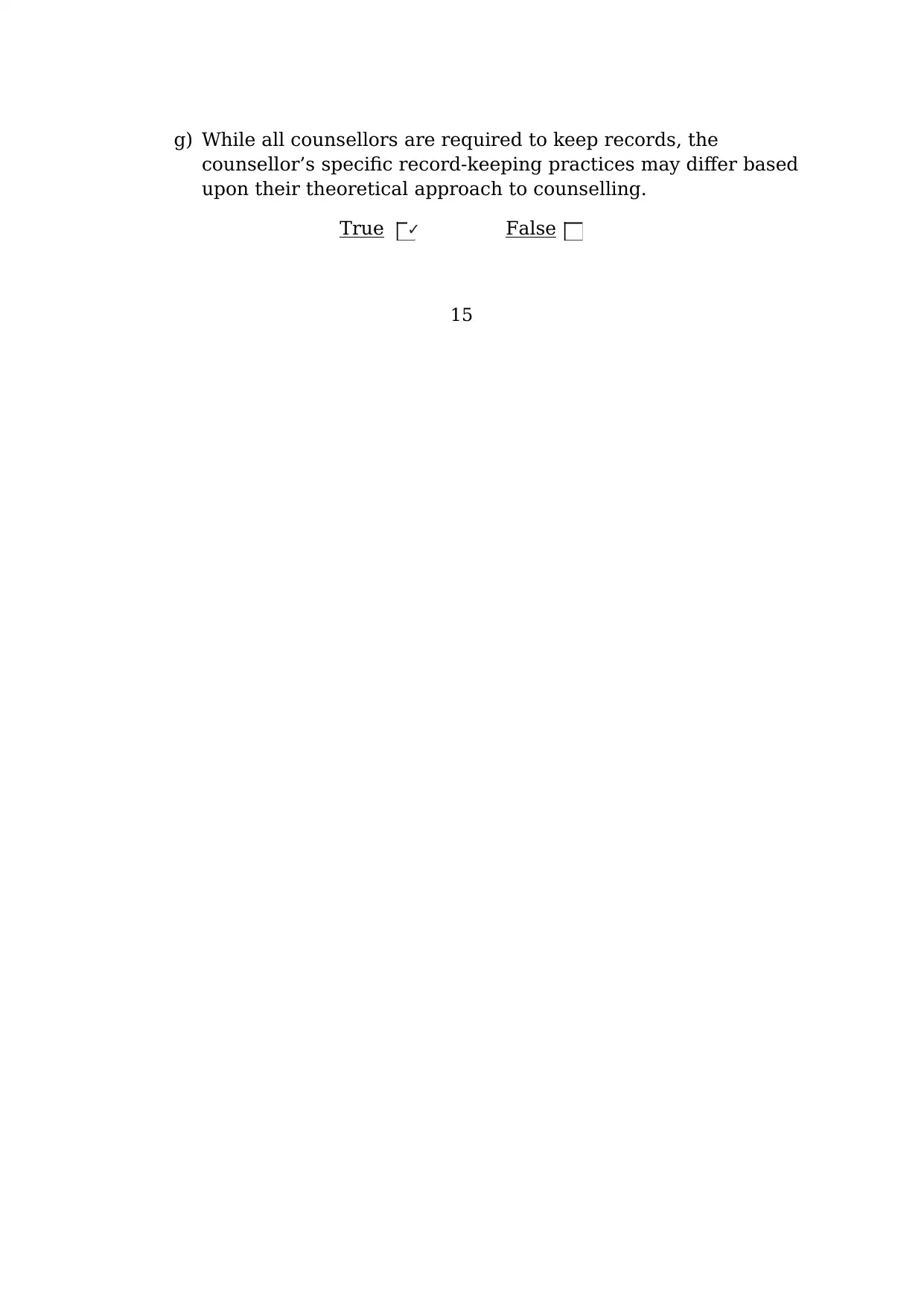
g) While all counsellors are required to keep records, the
counsellor’s specific record-keeping practices may differ based
upon their theoretical approach to counselling.
True ✓ False
15
counsellor’s specific record-keeping practices may differ based
upon their theoretical approach to counselling.
True ✓ False
15
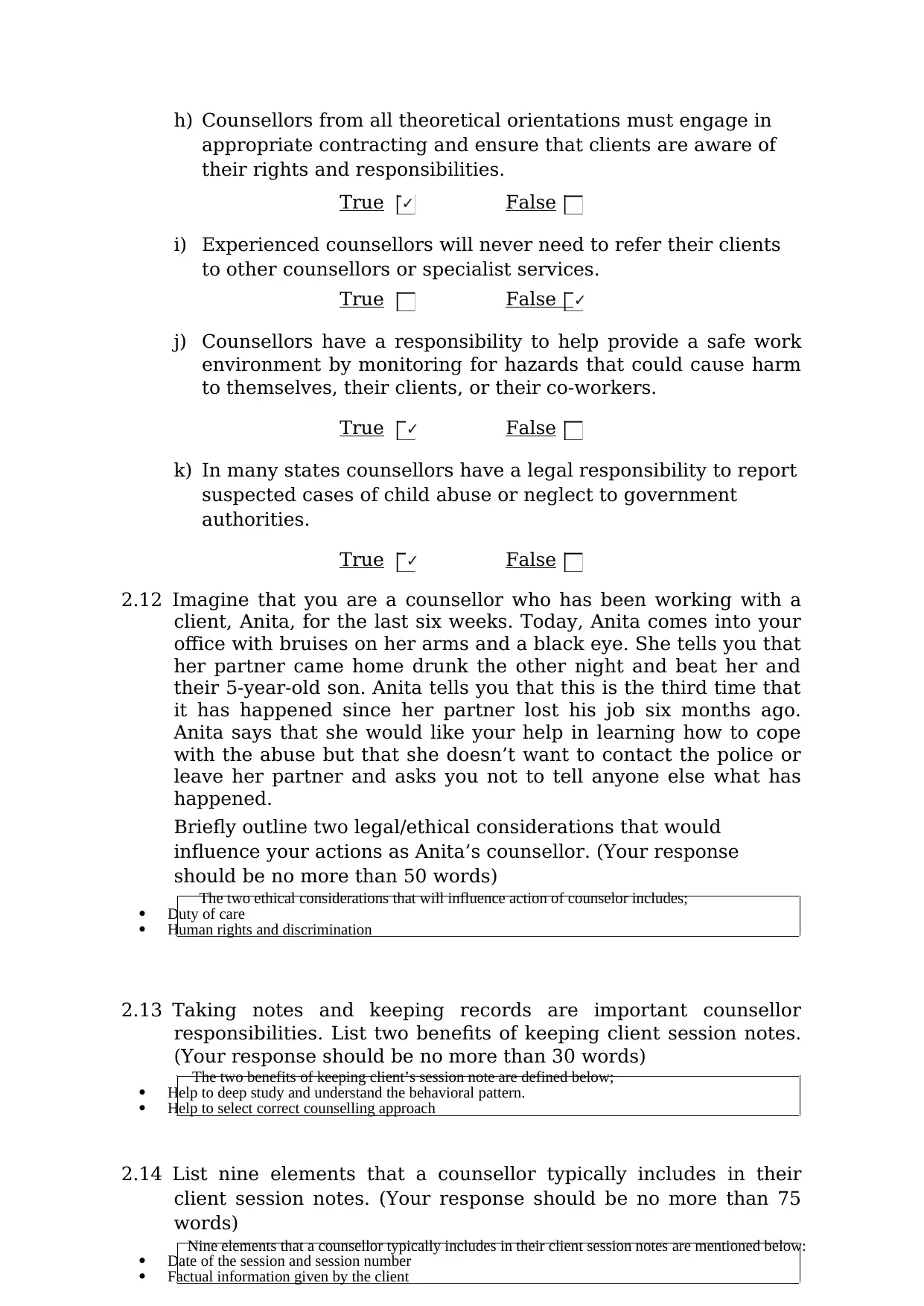
h) Counsellors from all theoretical orientations must engage in
appropriate contracting and ensure that clients are aware of
their rights and responsibilities.
True ✓ False
i) Experienced counsellors will never need to refer their clients
to other counsellors or specialist services.
True False ✓
j) Counsellors have a responsibility to help provide a safe work
environment by monitoring for hazards that could cause harm
to themselves, their clients, or their co-workers.
True ✓ False
k) In many states counsellors have a legal responsibility to report
suspected cases of child abuse or neglect to government
authorities.
True ✓ False
2.12 Imagine that you are a counsellor who has been working with a
client, Anita, for the last six weeks. Today, Anita comes into your
office with bruises on her arms and a black eye. She tells you that
her partner came home drunk the other night and beat her and
their 5-year-old son. Anita tells you that this is the third time that
it has happened since her partner lost his job six months ago.
Anita says that she would like your help in learning how to cope
with the abuse but that she doesn’t want to contact the police or
leave her partner and asks you not to tell anyone else what has
happened.
Briefly outline two legal/ethical considerations that would
influence your actions as Anita’s counsellor. (Your response
should be no more than 50 words)
The two ethical considerations that will influence action of counselor includes;
Duty of care
Human rights and discrimination
2.13 Taking notes and keeping records are important counsellor
responsibilities. List two benefits of keeping client session notes.
(Your response should be no more than 30 words)
The two benefits of keeping client’s session note are defined below;
Help to deep study and understand the behavioral pattern.
Help to select correct counselling approach
2.14 List nine elements that a counsellor typically includes in their
client session notes. (Your response should be no more than 75
words)
Nine elements that a counsellor typically includes in their client session notes are mentioned below:
Date of the session and session number
Factual information given by the client
appropriate contracting and ensure that clients are aware of
their rights and responsibilities.
True ✓ False
i) Experienced counsellors will never need to refer their clients
to other counsellors or specialist services.
True False ✓
j) Counsellors have a responsibility to help provide a safe work
environment by monitoring for hazards that could cause harm
to themselves, their clients, or their co-workers.
True ✓ False
k) In many states counsellors have a legal responsibility to report
suspected cases of child abuse or neglect to government
authorities.
True ✓ False
2.12 Imagine that you are a counsellor who has been working with a
client, Anita, for the last six weeks. Today, Anita comes into your
office with bruises on her arms and a black eye. She tells you that
her partner came home drunk the other night and beat her and
their 5-year-old son. Anita tells you that this is the third time that
it has happened since her partner lost his job six months ago.
Anita says that she would like your help in learning how to cope
with the abuse but that she doesn’t want to contact the police or
leave her partner and asks you not to tell anyone else what has
happened.
Briefly outline two legal/ethical considerations that would
influence your actions as Anita’s counsellor. (Your response
should be no more than 50 words)
The two ethical considerations that will influence action of counselor includes;
Duty of care
Human rights and discrimination
2.13 Taking notes and keeping records are important counsellor
responsibilities. List two benefits of keeping client session notes.
(Your response should be no more than 30 words)
The two benefits of keeping client’s session note are defined below;
Help to deep study and understand the behavioral pattern.
Help to select correct counselling approach
2.14 List nine elements that a counsellor typically includes in their
client session notes. (Your response should be no more than 75
words)
Nine elements that a counsellor typically includes in their client session notes are mentioned below:
Date of the session and session number
Factual information given by the client
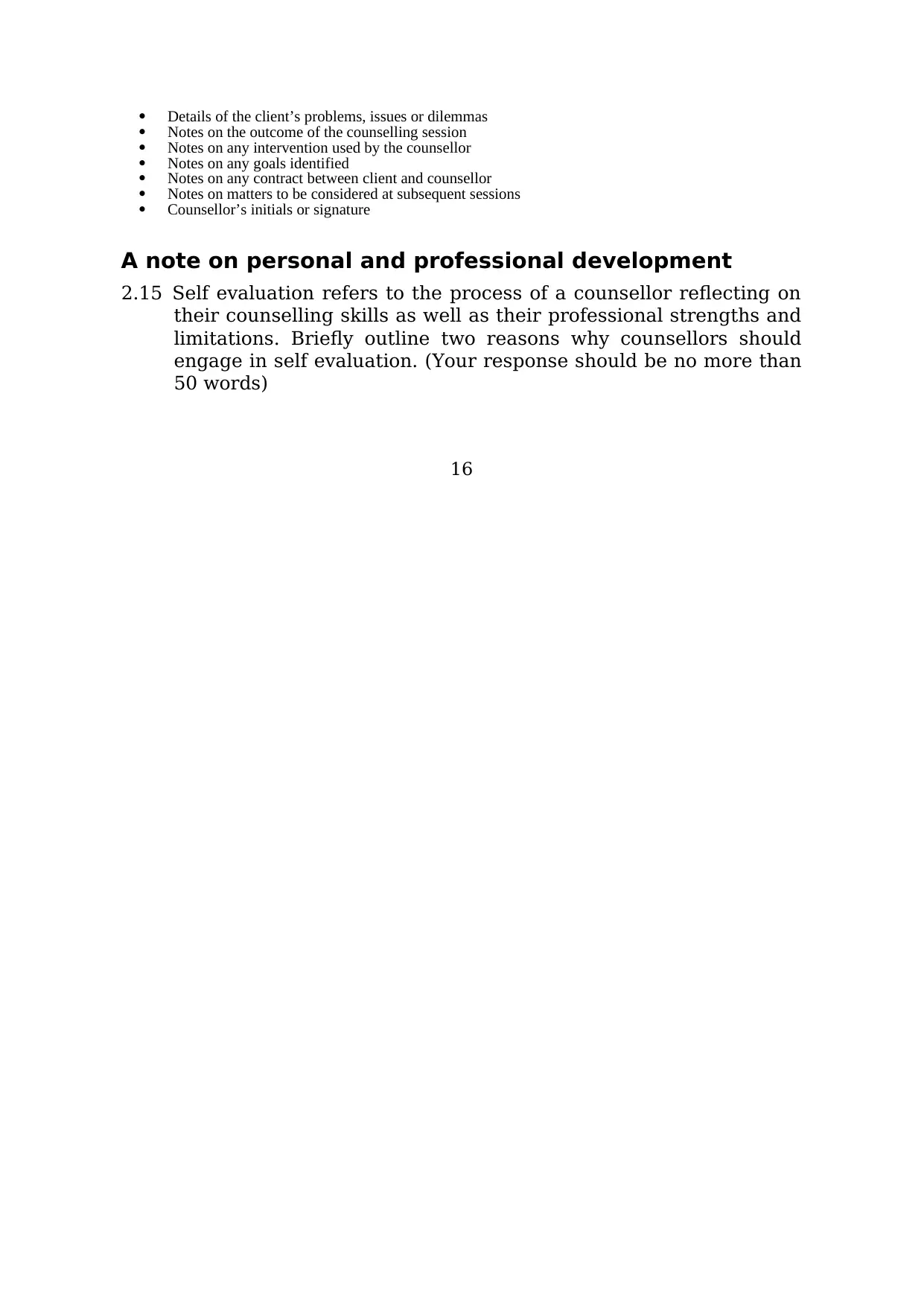
Details of the client’s problems, issues or dilemmas
Notes on the outcome of the counselling session
Notes on any intervention used by the counsellor
Notes on any goals identified
Notes on any contract between client and counsellor
Notes on matters to be considered at subsequent sessions
Counsellor’s initials or signature
A note on personal and professional development
2.15 Self evaluation refers to the process of a counsellor reflecting on
their counselling skills as well as their professional strengths and
limitations. Briefly outline two reasons why counsellors should
engage in self evaluation. (Your response should be no more than
50 words)
16
Notes on the outcome of the counselling session
Notes on any intervention used by the counsellor
Notes on any goals identified
Notes on any contract between client and counsellor
Notes on matters to be considered at subsequent sessions
Counsellor’s initials or signature
A note on personal and professional development
2.15 Self evaluation refers to the process of a counsellor reflecting on
their counselling skills as well as their professional strengths and
limitations. Briefly outline two reasons why counsellors should
engage in self evaluation. (Your response should be no more than
50 words)
16
Secure Best Marks with AI Grader
Need help grading? Try our AI Grader for instant feedback on your assignments.
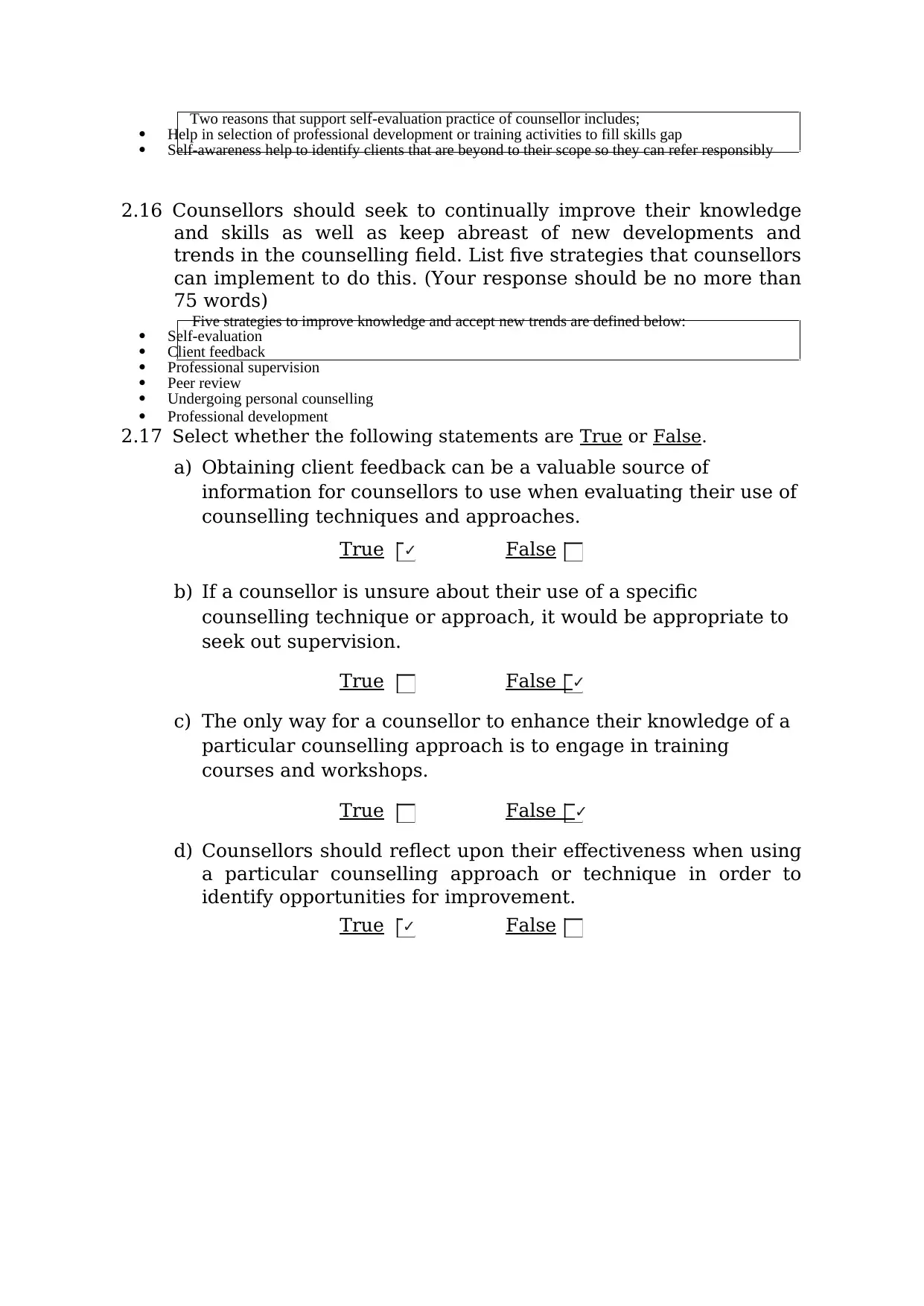
Two reasons that support self-evaluation practice of counsellor includes;
Help in selection of professional development or training activities to fill skills gap
Self-awareness help to identify clients that are beyond to their scope so they can refer responsibly
2.16 Counsellors should seek to continually improve their knowledge
and skills as well as keep abreast of new developments and
trends in the counselling field. List five strategies that counsellors
can implement to do this. (Your response should be no more than
75 words)
Five strategies to improve knowledge and accept new trends are defined below:
Self-evaluation
Client feedback
Professional supervision
Peer review
Undergoing personal counselling
Professional development
2.17 Select whether the following statements are True or False.
a) Obtaining client feedback can be a valuable source of
information for counsellors to use when evaluating their use of
counselling techniques and approaches.
True ✓ False
b) If a counsellor is unsure about their use of a specific
counselling technique or approach, it would be appropriate to
seek out supervision.
True False ✓
c) The only way for a counsellor to enhance their knowledge of a
particular counselling approach is to engage in training
courses and workshops.
True False ✓
d) Counsellors should reflect upon their effectiveness when using
a particular counselling approach or technique in order to
identify opportunities for improvement.
True ✓ False
Help in selection of professional development or training activities to fill skills gap
Self-awareness help to identify clients that are beyond to their scope so they can refer responsibly
2.16 Counsellors should seek to continually improve their knowledge
and skills as well as keep abreast of new developments and
trends in the counselling field. List five strategies that counsellors
can implement to do this. (Your response should be no more than
75 words)
Five strategies to improve knowledge and accept new trends are defined below:
Self-evaluation
Client feedback
Professional supervision
Peer review
Undergoing personal counselling
Professional development
2.17 Select whether the following statements are True or False.
a) Obtaining client feedback can be a valuable source of
information for counsellors to use when evaluating their use of
counselling techniques and approaches.
True ✓ False
b) If a counsellor is unsure about their use of a specific
counselling technique or approach, it would be appropriate to
seek out supervision.
True False ✓
c) The only way for a counsellor to enhance their knowledge of a
particular counselling approach is to engage in training
courses and workshops.
True False ✓
d) Counsellors should reflect upon their effectiveness when using
a particular counselling approach or technique in order to
identify opportunities for improvement.
True ✓ False
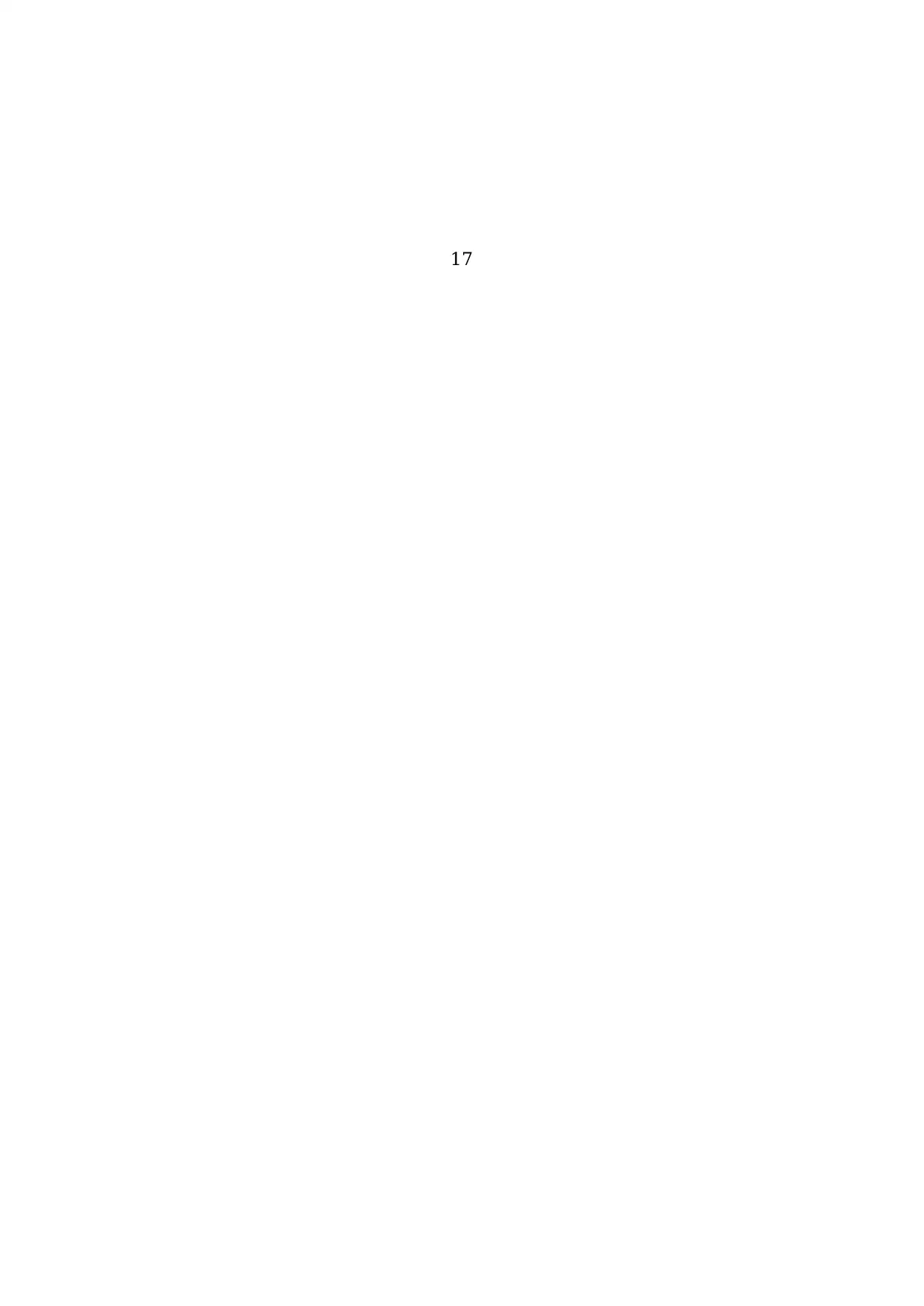
17
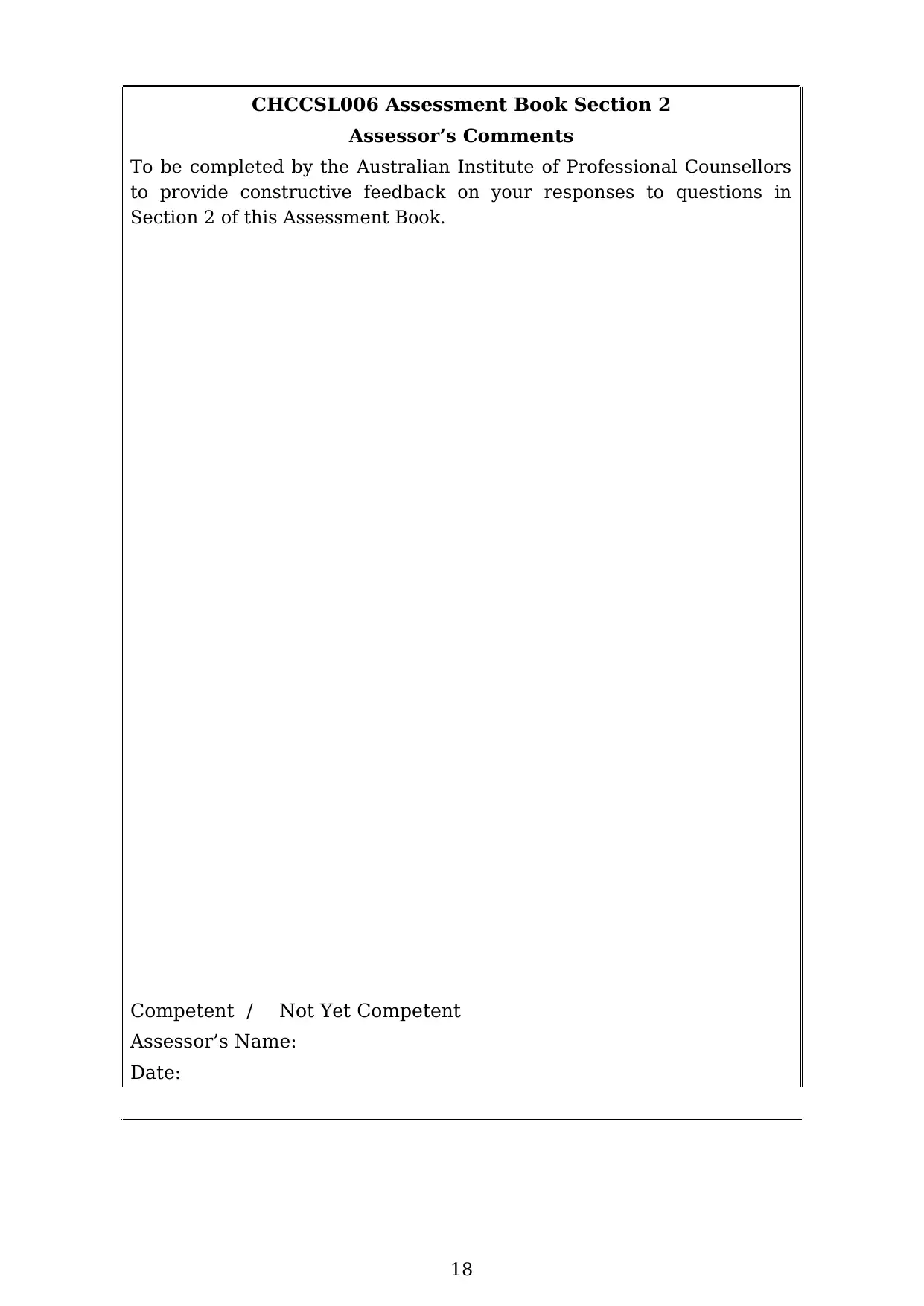
CHCCSL006 Assessment Book Section 2
Assessor’s Comments
To be completed by the Australian Institute of Professional Counsellors
to provide constructive feedback on your responses to questions in
Section 2 of this Assessment Book.
Competent / Not Yet Competent
Assessor’s Name:
Date:
18
Assessor’s Comments
To be completed by the Australian Institute of Professional Counsellors
to provide constructive feedback on your responses to questions in
Section 2 of this Assessment Book.
Competent / Not Yet Competent
Assessor’s Name:
Date:
18
Paraphrase This Document
Need a fresh take? Get an instant paraphrase of this document with our AI Paraphraser
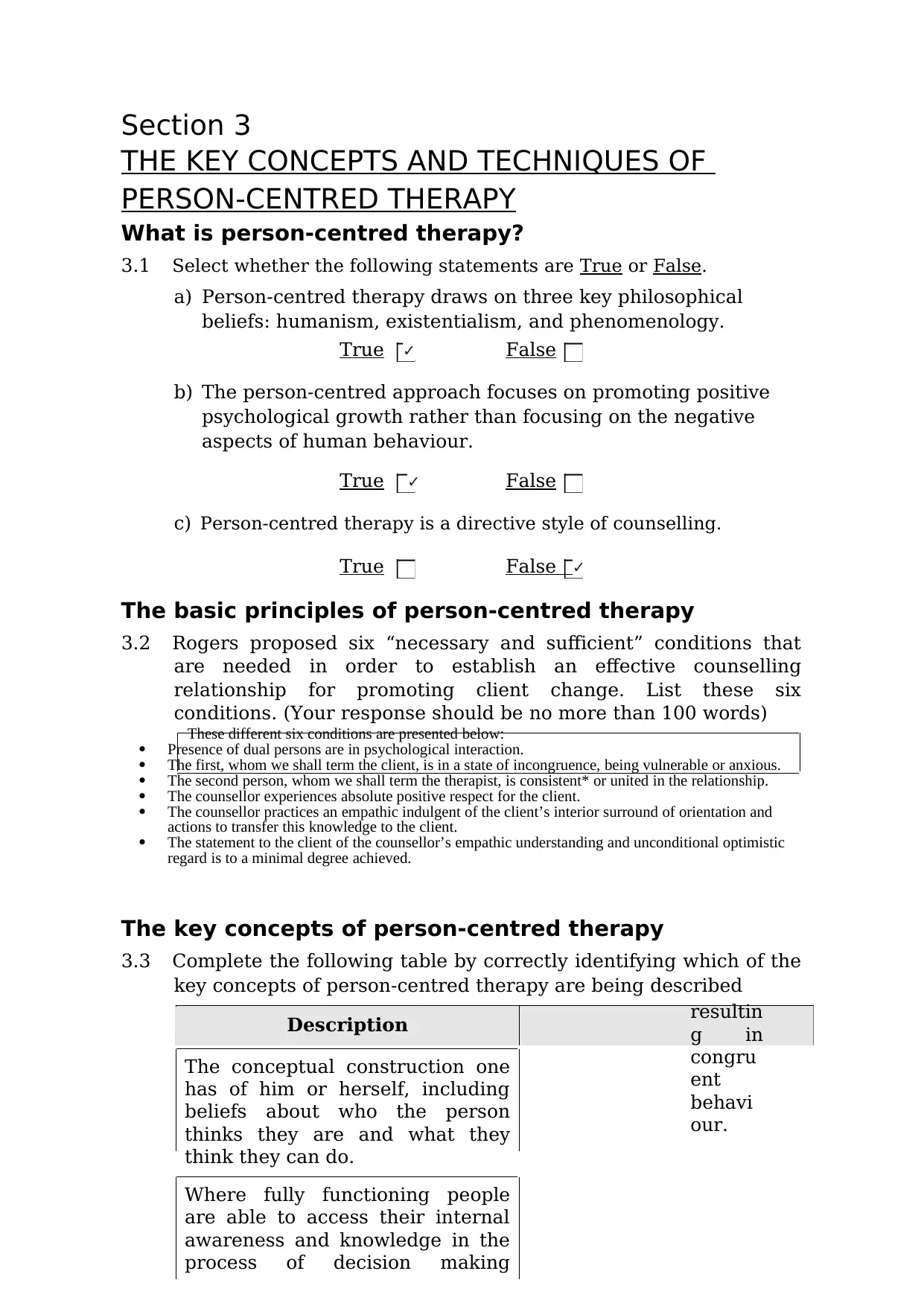
Section 3
THE KEY CONCEPTS AND TECHNIQUES OF
PERSON-CENTRED THERAPY
What is person-centred therapy?
3.1 Select whether the following statements are True or False.
a) Person-centred therapy draws on three key philosophical
beliefs: humanism, existentialism, and phenomenology.
True ✓ False
b) The person-centred approach focuses on promoting positive
psychological growth rather than focusing on the negative
aspects of human behaviour.
True ✓ False
c) Person-centred therapy is a directive style of counselling.
True False ✓
The basic principles of person-centred therapy
3.2 Rogers proposed six “necessary and sufficient” conditions that
are needed in order to establish an effective counselling
relationship for promoting client change. List these six
conditions. (Your response should be no more than 100 words)
These different six conditions are presented below:
Presence of dual persons are in psychological interaction.
The first, whom we shall term the client, is in a state of incongruence, being vulnerable or anxious.
The second person, whom we shall term the therapist, is consistent* or united in the relationship.
The counsellor experiences absolute positive respect for the client.
The counsellor practices an empathic indulgent of the client’s interior surround of orientation and
actions to transfer this knowledge to the client.
The statement to the client of the counsellor’s empathic understanding and unconditional optimistic
regard is to a minimal degree achieved.
The key concepts of person-centred therapy
3.3 Complete the following table by correctly identifying which of the
key concepts of person-centred therapy are being described
Description
The conceptual construction one
has of him or herself, including
beliefs about who the person
thinks they are and what they
think they can do.
Where fully functioning people
are able to access their internal
awareness and knowledge in the
process of decision making
resultin
g in
congru
ent
behavi
our.
THE KEY CONCEPTS AND TECHNIQUES OF
PERSON-CENTRED THERAPY
What is person-centred therapy?
3.1 Select whether the following statements are True or False.
a) Person-centred therapy draws on three key philosophical
beliefs: humanism, existentialism, and phenomenology.
True ✓ False
b) The person-centred approach focuses on promoting positive
psychological growth rather than focusing on the negative
aspects of human behaviour.
True ✓ False
c) Person-centred therapy is a directive style of counselling.
True False ✓
The basic principles of person-centred therapy
3.2 Rogers proposed six “necessary and sufficient” conditions that
are needed in order to establish an effective counselling
relationship for promoting client change. List these six
conditions. (Your response should be no more than 100 words)
These different six conditions are presented below:
Presence of dual persons are in psychological interaction.
The first, whom we shall term the client, is in a state of incongruence, being vulnerable or anxious.
The second person, whom we shall term the therapist, is consistent* or united in the relationship.
The counsellor experiences absolute positive respect for the client.
The counsellor practices an empathic indulgent of the client’s interior surround of orientation and
actions to transfer this knowledge to the client.
The statement to the client of the counsellor’s empathic understanding and unconditional optimistic
regard is to a minimal degree achieved.
The key concepts of person-centred therapy
3.3 Complete the following table by correctly identifying which of the
key concepts of person-centred therapy are being described
Description
The conceptual construction one
has of him or herself, including
beliefs about who the person
thinks they are and what they
think they can do.
Where fully functioning people
are able to access their internal
awareness and knowledge in the
process of decision making
resultin
g in
congru
ent
behavi
our.
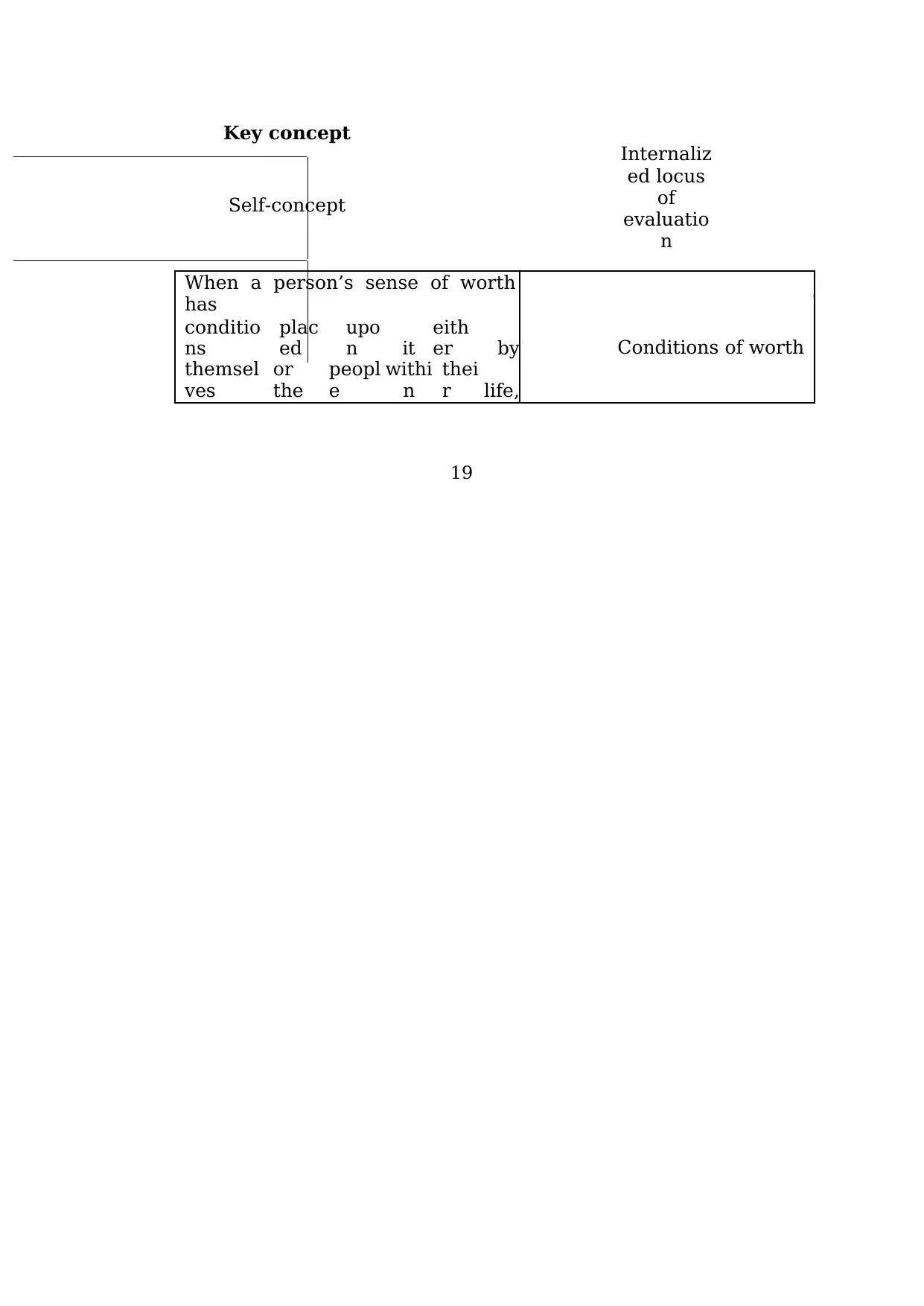
Key concept
Self-concept
Internaliz
ed locus
of
evaluatio
n
When a person’s sense of worth
has
Conditions of worth
conditio
ns
plac
ed
upo
n it
eith
er by
themsel
ves
or
the
peopl
e
withi
n
thei
r life,
19
Self-concept
Internaliz
ed locus
of
evaluatio
n
When a person’s sense of worth
has
Conditions of worth
conditio
ns
plac
ed
upo
n it
eith
er by
themsel
ves
or
the
peopl
e
withi
n
thei
r life,
19
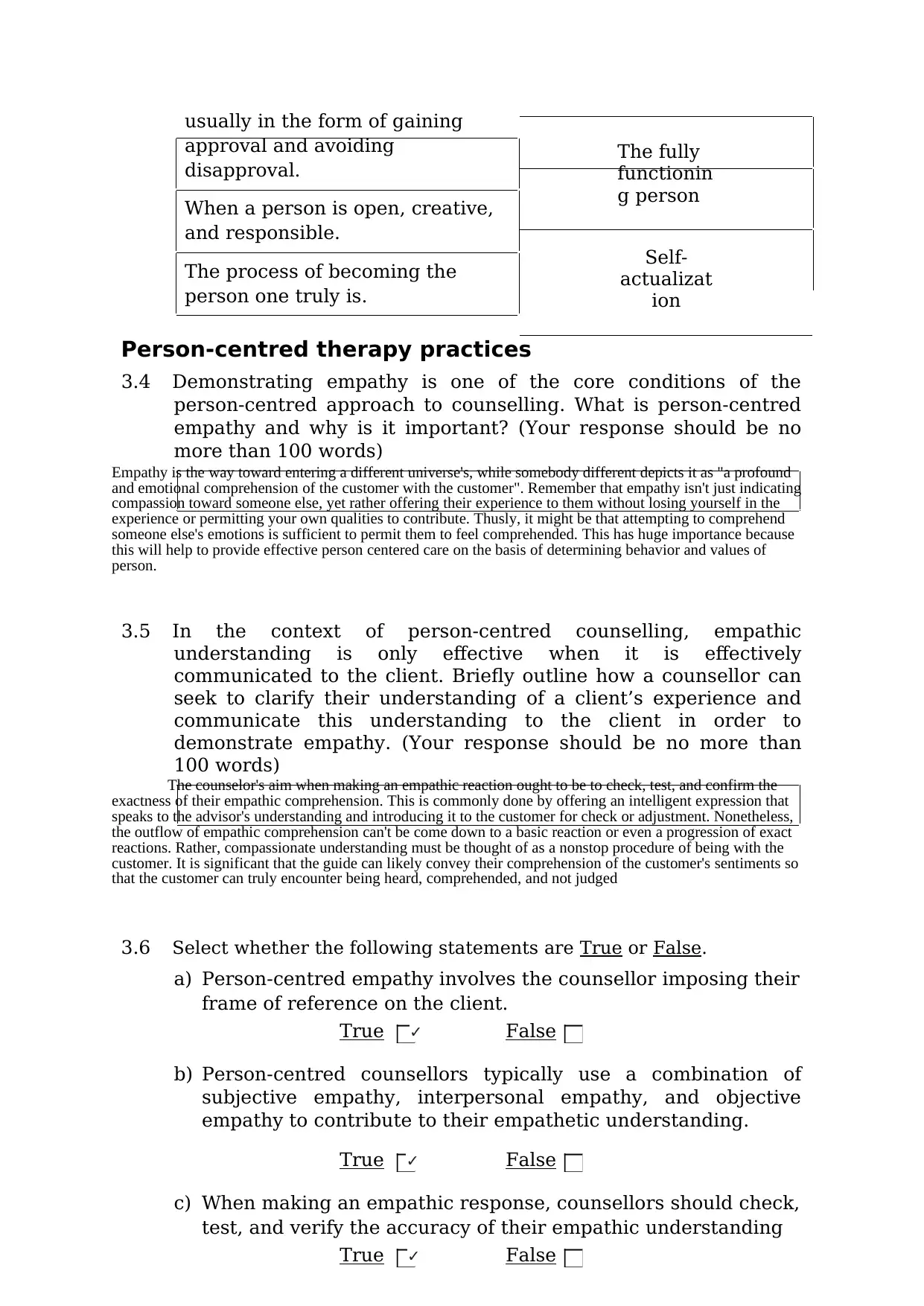
usually in the form of gaining
approval and avoiding
disapproval.
When a person is open, creative,
and responsible.
The process of becoming the
person one truly is.
The fully
functionin
g person
Self-
actualizat
ion
Person-centred therapy practices
3.4 Demonstrating empathy is one of the core conditions of the
person-centred approach to counselling. What is person-centred
empathy and why is it important? (Your response should be no
more than 100 words)
Empathy is the way toward entering a different universe's, while somebody different depicts it as "a profound
and emotional comprehension of the customer with the customer". Remember that empathy isn't just indicating
compassion toward someone else, yet rather offering their experience to them without losing yourself in the
experience or permitting your own qualities to contribute. Thusly, it might be that attempting to comprehend
someone else's emotions is sufficient to permit them to feel comprehended. This has huge importance because
this will help to provide effective person centered care on the basis of determining behavior and values of
person.
3.5 In the context of person-centred counselling, empathic
understanding is only effective when it is effectively
communicated to the client. Briefly outline how a counsellor can
seek to clarify their understanding of a client’s experience and
communicate this understanding to the client in order to
demonstrate empathy. (Your response should be no more than
100 words)
The counselor's aim when making an empathic reaction ought to be to check, test, and confirm the
exactness of their empathic comprehension. This is commonly done by offering an intelligent expression that
speaks to the advisor's understanding and introducing it to the customer for check or adjustment. Nonetheless,
the outflow of empathic comprehension can't be come down to a basic reaction or even a progression of exact
reactions. Rather, compassionate understanding must be thought of as a nonstop procedure of being with the
customer. It is significant that the guide can likely convey their comprehension of the customer's sentiments so
that the customer can truly encounter being heard, comprehended, and not judged
3.6 Select whether the following statements are True or False.
a) Person-centred empathy involves the counsellor imposing their
frame of reference on the client.
True ✓ False
b) Person-centred counsellors typically use a combination of
subjective empathy, interpersonal empathy, and objective
empathy to contribute to their empathetic understanding.
True ✓ False
c) When making an empathic response, counsellors should check,
test, and verify the accuracy of their empathic understanding
True ✓ False
approval and avoiding
disapproval.
When a person is open, creative,
and responsible.
The process of becoming the
person one truly is.
The fully
functionin
g person
Self-
actualizat
ion
Person-centred therapy practices
3.4 Demonstrating empathy is one of the core conditions of the
person-centred approach to counselling. What is person-centred
empathy and why is it important? (Your response should be no
more than 100 words)
Empathy is the way toward entering a different universe's, while somebody different depicts it as "a profound
and emotional comprehension of the customer with the customer". Remember that empathy isn't just indicating
compassion toward someone else, yet rather offering their experience to them without losing yourself in the
experience or permitting your own qualities to contribute. Thusly, it might be that attempting to comprehend
someone else's emotions is sufficient to permit them to feel comprehended. This has huge importance because
this will help to provide effective person centered care on the basis of determining behavior and values of
person.
3.5 In the context of person-centred counselling, empathic
understanding is only effective when it is effectively
communicated to the client. Briefly outline how a counsellor can
seek to clarify their understanding of a client’s experience and
communicate this understanding to the client in order to
demonstrate empathy. (Your response should be no more than
100 words)
The counselor's aim when making an empathic reaction ought to be to check, test, and confirm the
exactness of their empathic comprehension. This is commonly done by offering an intelligent expression that
speaks to the advisor's understanding and introducing it to the customer for check or adjustment. Nonetheless,
the outflow of empathic comprehension can't be come down to a basic reaction or even a progression of exact
reactions. Rather, compassionate understanding must be thought of as a nonstop procedure of being with the
customer. It is significant that the guide can likely convey their comprehension of the customer's sentiments so
that the customer can truly encounter being heard, comprehended, and not judged
3.6 Select whether the following statements are True or False.
a) Person-centred empathy involves the counsellor imposing their
frame of reference on the client.
True ✓ False
b) Person-centred counsellors typically use a combination of
subjective empathy, interpersonal empathy, and objective
empathy to contribute to their empathetic understanding.
True ✓ False
c) When making an empathic response, counsellors should check,
test, and verify the accuracy of their empathic understanding
True ✓ False
Secure Best Marks with AI Grader
Need help grading? Try our AI Grader for instant feedback on your assignments.

d) Effective person-centred empathy involves the counsellor
losing themselves in the experience of the client.
True False ✓
3.7 The second core condition of person-centred counselling is for
counsellor to be congruent in the therapeutic relationship. What
does congruence entail within person-centred counselling and
why is it important? (Your response should be no more than 100
words)
20
losing themselves in the experience of the client.
True False ✓
3.7 The second core condition of person-centred counselling is for
counsellor to be congruent in the therapeutic relationship. What
does congruence entail within person-centred counselling and
why is it important? (Your response should be no more than 100
words)
20
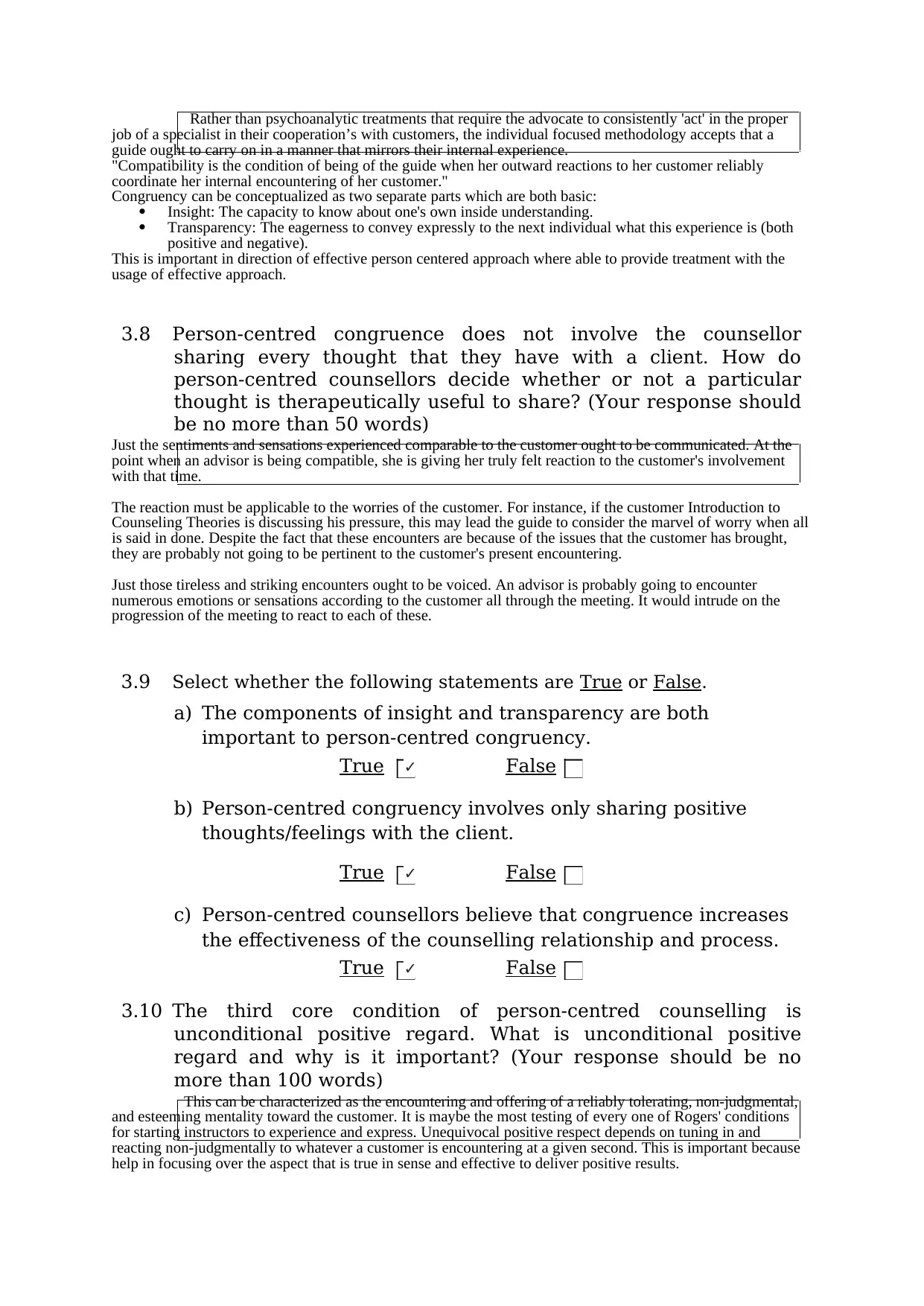
Rather than psychoanalytic treatments that require the advocate to consistently 'act' in the proper
job of a specialist in their cooperation’s with customers, the individual focused methodology accepts that a
guide ought to carry on in a manner that mirrors their internal experience.
"Compatibility is the condition of being of the guide when her outward reactions to her customer reliably
coordinate her internal encountering of her customer."
Congruency can be conceptualized as two separate parts which are both basic:
Insight: The capacity to know about one's own inside understanding.
Transparency: The eagerness to convey expressly to the next individual what this experience is (both
positive and negative).
This is important in direction of effective person centered approach where able to provide treatment with the
usage of effective approach.
3.8 Person-centred congruence does not involve the counsellor
sharing every thought that they have with a client. How do
person-centred counsellors decide whether or not a particular
thought is therapeutically useful to share? (Your response should
be no more than 50 words)
Just the sentiments and sensations experienced comparable to the customer ought to be communicated. At the
point when an advisor is being compatible, she is giving her truly felt reaction to the customer's involvement
with that time.
The reaction must be applicable to the worries of the customer. For instance, if the customer Introduction to
Counseling Theories is discussing his pressure, this may lead the guide to consider the marvel of worry when all
is said in done. Despite the fact that these encounters are because of the issues that the customer has brought,
they are probably not going to be pertinent to the customer's present encountering.
Just those tireless and striking encounters ought to be voiced. An advisor is probably going to encounter
numerous emotions or sensations according to the customer all through the meeting. It would intrude on the
progression of the meeting to react to each of these.
3.9 Select whether the following statements are True or False.
a) The components of insight and transparency are both
important to person-centred congruency.
True ✓ False
b) Person-centred congruency involves only sharing positive
thoughts/feelings with the client.
True ✓ False
c) Person-centred counsellors believe that congruence increases
the effectiveness of the counselling relationship and process.
True ✓ False
3.10 The third core condition of person-centred counselling is
unconditional positive regard. What is unconditional positive
regard and why is it important? (Your response should be no
more than 100 words)
This can be characterized as the encountering and offering of a reliably tolerating, non-judgmental,
and esteeming mentality toward the customer. It is maybe the most testing of every one of Rogers' conditions
for starting instructors to experience and express. Unequivocal positive respect depends on tuning in and
reacting non-judgmentally to whatever a customer is encountering at a given second. This is important because
help in focusing over the aspect that is true in sense and effective to deliver positive results.
job of a specialist in their cooperation’s with customers, the individual focused methodology accepts that a
guide ought to carry on in a manner that mirrors their internal experience.
"Compatibility is the condition of being of the guide when her outward reactions to her customer reliably
coordinate her internal encountering of her customer."
Congruency can be conceptualized as two separate parts which are both basic:
Insight: The capacity to know about one's own inside understanding.
Transparency: The eagerness to convey expressly to the next individual what this experience is (both
positive and negative).
This is important in direction of effective person centered approach where able to provide treatment with the
usage of effective approach.
3.8 Person-centred congruence does not involve the counsellor
sharing every thought that they have with a client. How do
person-centred counsellors decide whether or not a particular
thought is therapeutically useful to share? (Your response should
be no more than 50 words)
Just the sentiments and sensations experienced comparable to the customer ought to be communicated. At the
point when an advisor is being compatible, she is giving her truly felt reaction to the customer's involvement
with that time.
The reaction must be applicable to the worries of the customer. For instance, if the customer Introduction to
Counseling Theories is discussing his pressure, this may lead the guide to consider the marvel of worry when all
is said in done. Despite the fact that these encounters are because of the issues that the customer has brought,
they are probably not going to be pertinent to the customer's present encountering.
Just those tireless and striking encounters ought to be voiced. An advisor is probably going to encounter
numerous emotions or sensations according to the customer all through the meeting. It would intrude on the
progression of the meeting to react to each of these.
3.9 Select whether the following statements are True or False.
a) The components of insight and transparency are both
important to person-centred congruency.
True ✓ False
b) Person-centred congruency involves only sharing positive
thoughts/feelings with the client.
True ✓ False
c) Person-centred counsellors believe that congruence increases
the effectiveness of the counselling relationship and process.
True ✓ False
3.10 The third core condition of person-centred counselling is
unconditional positive regard. What is unconditional positive
regard and why is it important? (Your response should be no
more than 100 words)
This can be characterized as the encountering and offering of a reliably tolerating, non-judgmental,
and esteeming mentality toward the customer. It is maybe the most testing of every one of Rogers' conditions
for starting instructors to experience and express. Unequivocal positive respect depends on tuning in and
reacting non-judgmentally to whatever a customer is encountering at a given second. This is important because
help in focusing over the aspect that is true in sense and effective to deliver positive results.
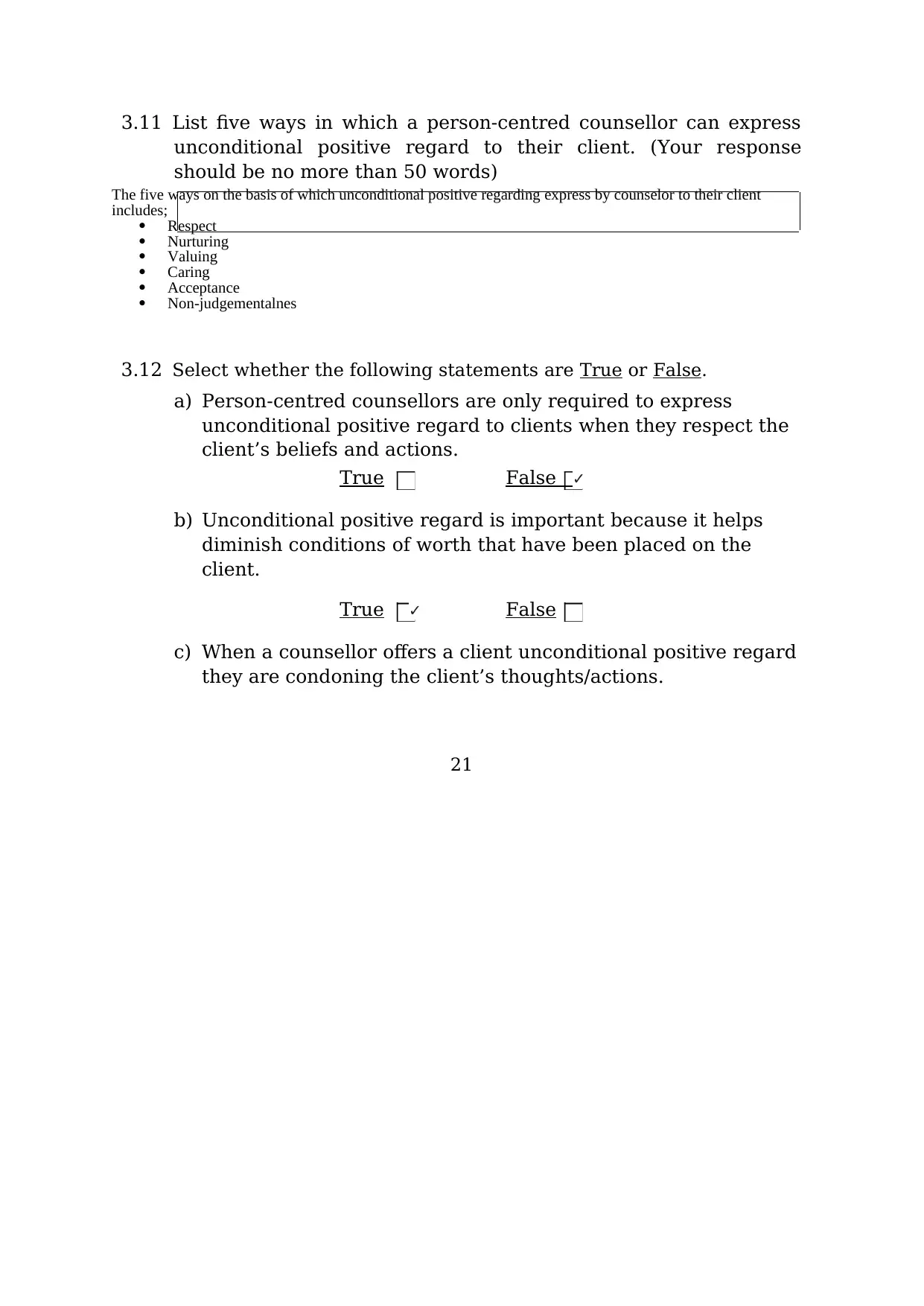
3.11 List five ways in which a person-centred counsellor can express
unconditional positive regard to their client. (Your response
should be no more than 50 words)
The five ways on the basis of which unconditional positive regarding express by counselor to their client
includes;
Respect
Nurturing
Valuing
Caring
Acceptance
Non-judgementalnes
3.12 Select whether the following statements are True or False.
a) Person-centred counsellors are only required to express
unconditional positive regard to clients when they respect the
client’s beliefs and actions.
True False ✓
b) Unconditional positive regard is important because it helps
diminish conditions of worth that have been placed on the
client.
True ✓ False
c) When a counsellor offers a client unconditional positive regard
they are condoning the client’s thoughts/actions.
21
unconditional positive regard to their client. (Your response
should be no more than 50 words)
The five ways on the basis of which unconditional positive regarding express by counselor to their client
includes;
Respect
Nurturing
Valuing
Caring
Acceptance
Non-judgementalnes
3.12 Select whether the following statements are True or False.
a) Person-centred counsellors are only required to express
unconditional positive regard to clients when they respect the
client’s beliefs and actions.
True False ✓
b) Unconditional positive regard is important because it helps
diminish conditions of worth that have been placed on the
client.
True ✓ False
c) When a counsellor offers a client unconditional positive regard
they are condoning the client’s thoughts/actions.
21
Paraphrase This Document
Need a fresh take? Get an instant paraphrase of this document with our AI Paraphraser

True ✓ False
The role of the counsellor and client
3.13 Which of the following statement(s) is/are correct in regard to the
roles of the counsellor and client in person-centred therapy?
a) The counsellor’s role is to tell the client how to self-actualise.
b) The client’s role is to explore their thoughts and feelings.
c) The counsellor’s role is to be present, congruent, accepting,
and empathetic in order to provide a growth-promoting
therapeutic climate.
d) The client’s role is to follow the counsellor’s directions
e) All of the above
f) A and D
g) B and C
h) A, B and C
i) B, C and D
Your response: e
3.14 Select whether the following statements are True or False.
a) Person-centred counsellors should fulfil the client’s need to
have an external authority figure tell them how to conduct
their life.
True ✓ False
b) In person-centred counselling, the client should determine the
focus of the counselling conversation.
True ✓ False
c) Effective person-centred counsellors seek to apply the core
conditions of person-centred therapy even when using basic
counselling microskills.
True ✓ False
The process of person-centred therapy
3.15 Rogers proposed seven stages that clients can undergo during the
person-centred therapeutic process. Complete the table below by
correctly labelling each of the following stage descriptions.
Description
During this stage the client generally
talks about themselves as an object
and typically avoids discussion of
present events.
During this stage the client can
express their emotions and is
beginning to rely more on their
decision making abilities and
increasi
ngly
accepts
more
responsi
bility for
their
actions.
The role of the counsellor and client
3.13 Which of the following statement(s) is/are correct in regard to the
roles of the counsellor and client in person-centred therapy?
a) The counsellor’s role is to tell the client how to self-actualise.
b) The client’s role is to explore their thoughts and feelings.
c) The counsellor’s role is to be present, congruent, accepting,
and empathetic in order to provide a growth-promoting
therapeutic climate.
d) The client’s role is to follow the counsellor’s directions
e) All of the above
f) A and D
g) B and C
h) A, B and C
i) B, C and D
Your response: e
3.14 Select whether the following statements are True or False.
a) Person-centred counsellors should fulfil the client’s need to
have an external authority figure tell them how to conduct
their life.
True ✓ False
b) In person-centred counselling, the client should determine the
focus of the counselling conversation.
True ✓ False
c) Effective person-centred counsellors seek to apply the core
conditions of person-centred therapy even when using basic
counselling microskills.
True ✓ False
The process of person-centred therapy
3.15 Rogers proposed seven stages that clients can undergo during the
person-centred therapeutic process. Complete the table below by
correctly labelling each of the following stage descriptions.
Description
During this stage the client generally
talks about themselves as an object
and typically avoids discussion of
present events.
During this stage the client can
express their emotions and is
beginning to rely more on their
decision making abilities and
increasi
ngly
accepts
more
responsi
bility for
their
actions.
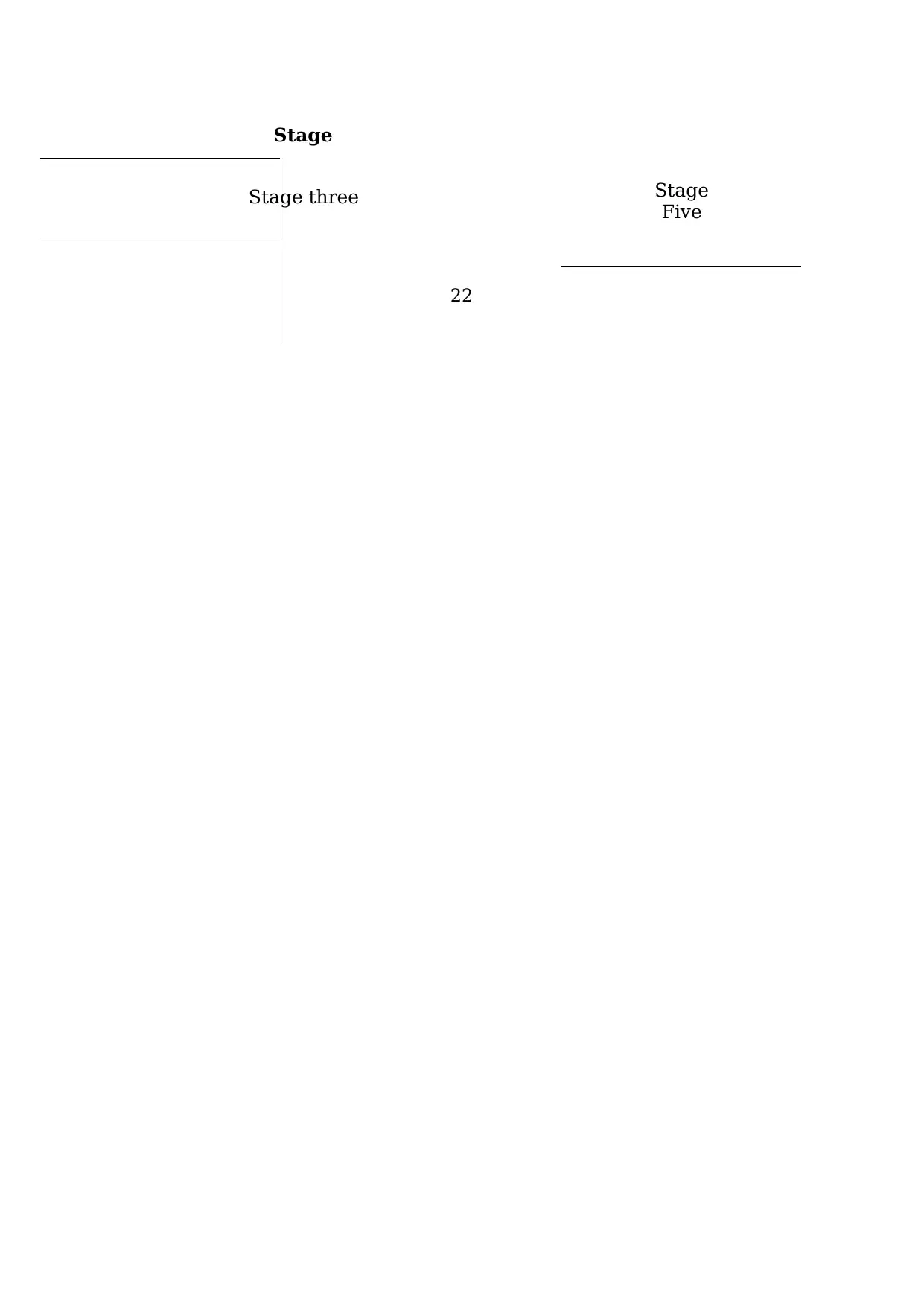
Stage
Stage three Stage
Five
22
Stage three Stage
Five
22

During this stage the client is a fully
functioning, self-actualising individual
who is empathic and shows
unconditional positive regard for
others.
During this stage the client is very
defensive and extremely resistant to
change.
During this stage the client begins to
talk about deep feelings and develops
a relationship with the counsellor.
During this stage the client shows
rapid growth towards congruence and
begins to develop unconditional
positive regard for others.
During this stage the client becomes
less rigid and will begin talking about
external events and other people.
Stage
Seven
Stage
One
Stage
Four
Stage Six
Stage
Two
3.16 Just like other forms of counselling, it is important for person -
centred counsellors to monitor and evaluate the counselling
process. Considering what you have learned about the person-
centred approach, what type of monitoring and evaluation do you
think is most important in person-centred counselling? Why?
(Your response should be no more than 50 words)
As in different treatments and types of advising, it is valuable to screen and assess the directing procedure. In
person-focused treatment, the most significant piece of the assessment procedure is the customer's assessment.
Because of the customer centered nature of this methodology, is dependent upon the customer to choose what
points or issues are talked about, the amount to investigate, regardless of whether the advising has been
compelling, and when they might want to end directing. Inside personcentred treatment, criticism from
customers is typically assembled verbally all the time with the customer, nonetheless, input can likewise be
accumulated through utilization of an input structure that would then be able to be talked about with the
customer.
The benefits and limitations of person-centred
counselling
3.17 For each of the following clients, identify whether or not person-
centred therapy would be an appropriate approach for the client.
Justify your response. Hint: consider the benefits and limitations
of using the person-centred approach to address each client’s
needs / issues / goals. (Your response should be no more than 30
words)
a) Paula is a 36 year old woman who has just discovered that she
is pregnant. Paula is married and already has two children, 12
year old Sam and 8 year old Bella. This pregnancy is
unplanned and Paula is not sure that she wants to take it to
term. Paula considers her family to be ‘complete’ but she
knows that her husband, Tim, will be thrilled because he
functioning, self-actualising individual
who is empathic and shows
unconditional positive regard for
others.
During this stage the client is very
defensive and extremely resistant to
change.
During this stage the client begins to
talk about deep feelings and develops
a relationship with the counsellor.
During this stage the client shows
rapid growth towards congruence and
begins to develop unconditional
positive regard for others.
During this stage the client becomes
less rigid and will begin talking about
external events and other people.
Stage
Seven
Stage
One
Stage
Four
Stage Six
Stage
Two
3.16 Just like other forms of counselling, it is important for person -
centred counsellors to monitor and evaluate the counselling
process. Considering what you have learned about the person-
centred approach, what type of monitoring and evaluation do you
think is most important in person-centred counselling? Why?
(Your response should be no more than 50 words)
As in different treatments and types of advising, it is valuable to screen and assess the directing procedure. In
person-focused treatment, the most significant piece of the assessment procedure is the customer's assessment.
Because of the customer centered nature of this methodology, is dependent upon the customer to choose what
points or issues are talked about, the amount to investigate, regardless of whether the advising has been
compelling, and when they might want to end directing. Inside personcentred treatment, criticism from
customers is typically assembled verbally all the time with the customer, nonetheless, input can likewise be
accumulated through utilization of an input structure that would then be able to be talked about with the
customer.
The benefits and limitations of person-centred
counselling
3.17 For each of the following clients, identify whether or not person-
centred therapy would be an appropriate approach for the client.
Justify your response. Hint: consider the benefits and limitations
of using the person-centred approach to address each client’s
needs / issues / goals. (Your response should be no more than 30
words)
a) Paula is a 36 year old woman who has just discovered that she
is pregnant. Paula is married and already has two children, 12
year old Sam and 8 year old Bella. This pregnancy is
unplanned and Paula is not sure that she wants to take it to
term. Paula considers her family to be ‘complete’ but she
knows that her husband, Tim, will be thrilled because he
Secure Best Marks with AI Grader
Need help grading? Try our AI Grader for instant feedback on your assignments.
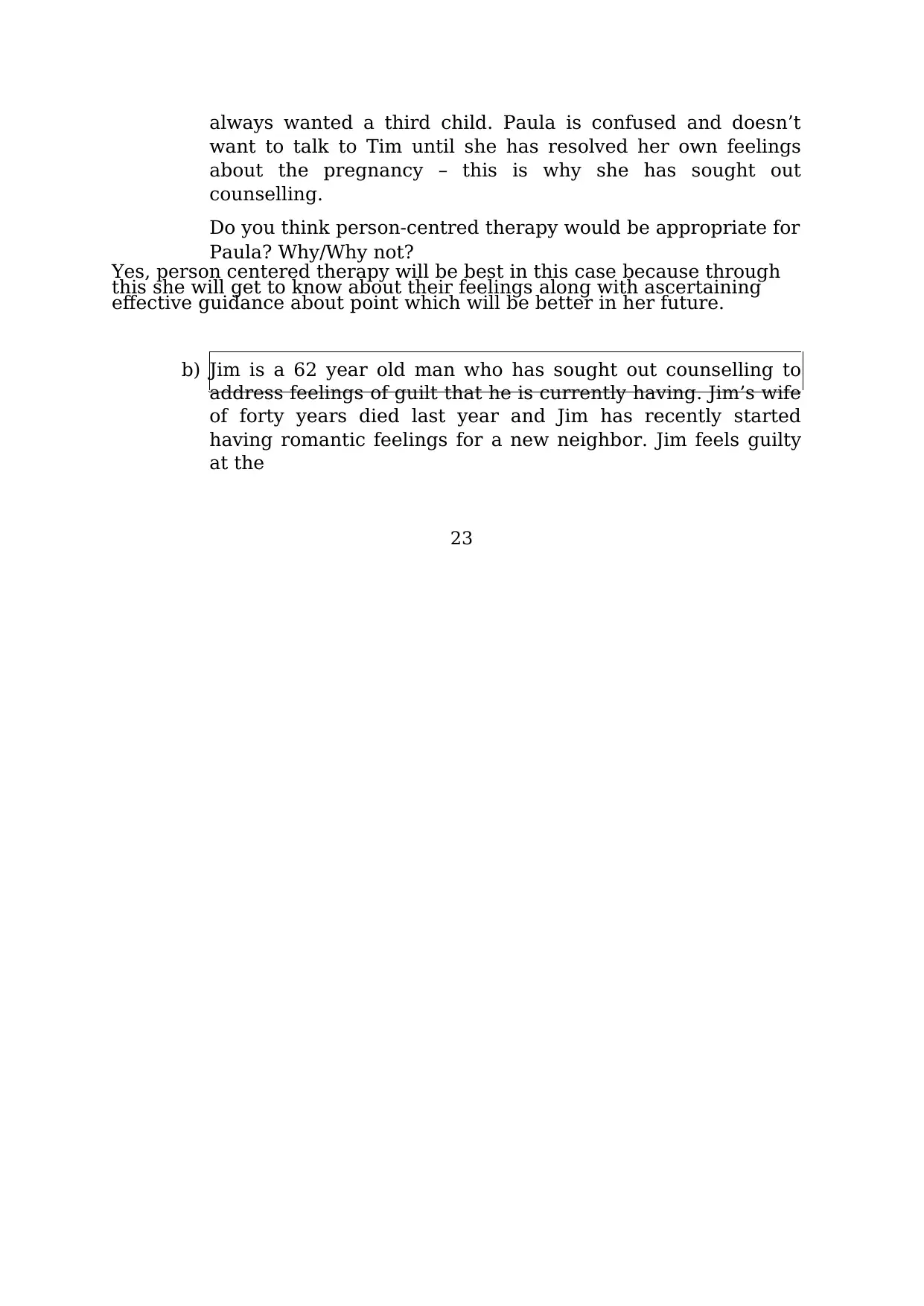
always wanted a third child. Paula is confused and doesn’t
want to talk to Tim until she has resolved her own feelings
about the pregnancy – this is why she has sought out
counselling.
Do you think person-centred therapy would be appropriate for
Paula? Why/Why not?
Yes, person centered therapy will be best in this case because through
this she will get to know about their feelings along with ascertaining
effective guidance about point which will be better in her future.
b) Jim is a 62 year old man who has sought out counselling to
address feelings of guilt that he is currently having. Jim’s wife
of forty years died last year and Jim has recently started
having romantic feelings for a new neighbor. Jim feels guilty
at the
23
want to talk to Tim until she has resolved her own feelings
about the pregnancy – this is why she has sought out
counselling.
Do you think person-centred therapy would be appropriate for
Paula? Why/Why not?
Yes, person centered therapy will be best in this case because through
this she will get to know about their feelings along with ascertaining
effective guidance about point which will be better in her future.
b) Jim is a 62 year old man who has sought out counselling to
address feelings of guilt that he is currently having. Jim’s wife
of forty years died last year and Jim has recently started
having romantic feelings for a new neighbor. Jim feels guilty
at the
23
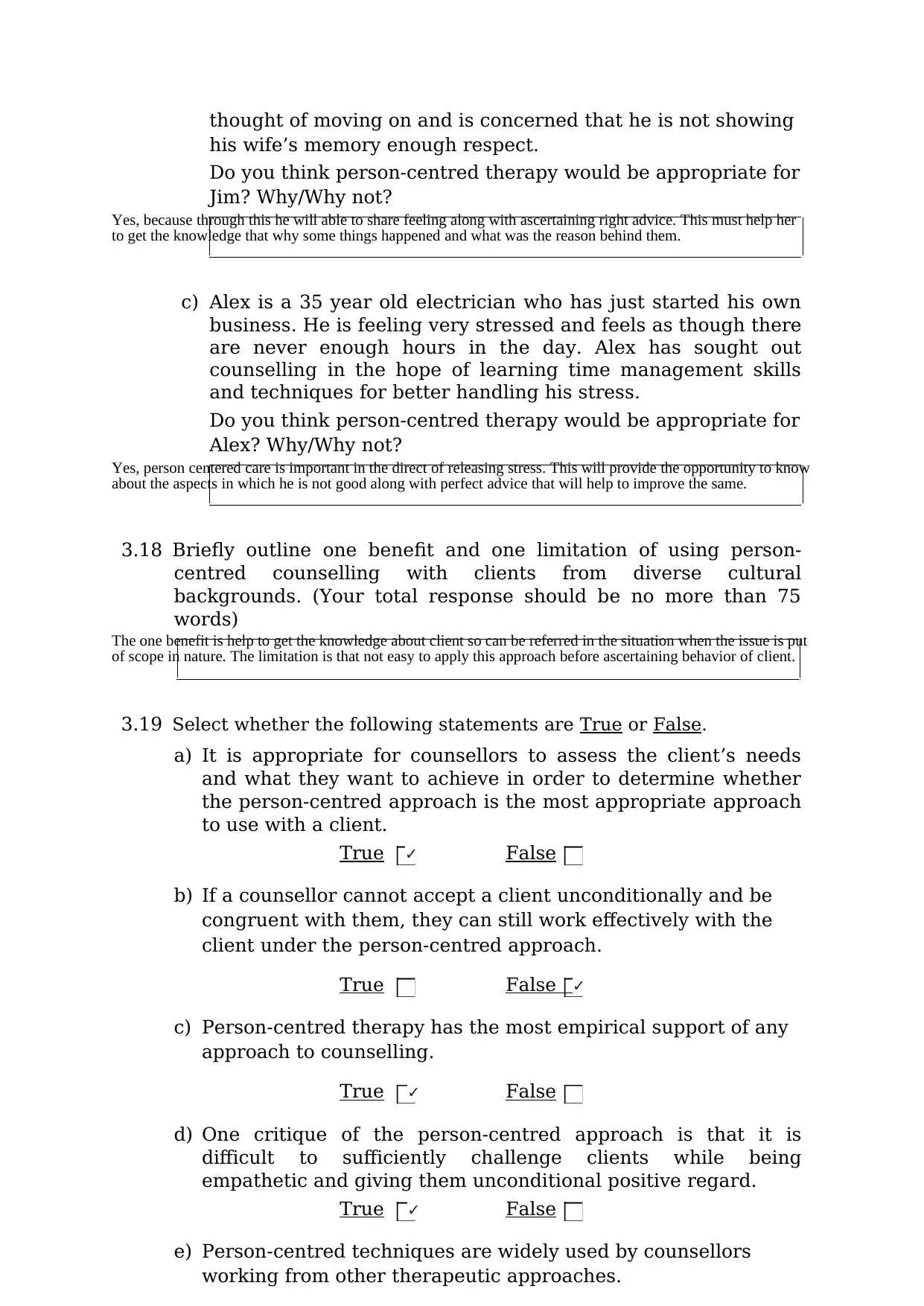
thought of moving on and is concerned that he is not showing
his wife’s memory enough respect.
Do you think person-centred therapy would be appropriate for
Jim? Why/Why not?
Yes, because through this he will able to share feeling along with ascertaining right advice. This must help her
to get the knowledge that why some things happened and what was the reason behind them.
c) Alex is a 35 year old electrician who has just started his own
business. He is feeling very stressed and feels as though there
are never enough hours in the day. Alex has sought out
counselling in the hope of learning time management skills
and techniques for better handling his stress.
Do you think person-centred therapy would be appropriate for
Alex? Why/Why not?
Yes, person centered care is important in the direct of releasing stress. This will provide the opportunity to know
about the aspects in which he is not good along with perfect advice that will help to improve the same.
3.18 Briefly outline one benefit and one limitation of using person-
centred counselling with clients from diverse cultural
backgrounds. (Your total response should be no more than 75
words)
The one benefit is help to get the knowledge about client so can be referred in the situation when the issue is put
of scope in nature. The limitation is that not easy to apply this approach before ascertaining behavior of client.
3.19 Select whether the following statements are True or False.
a) It is appropriate for counsellors to assess the client’s needs
and what they want to achieve in order to determine whether
the person-centred approach is the most appropriate approach
to use with a client.
True ✓ False
b) If a counsellor cannot accept a client unconditionally and be
congruent with them, they can still work effectively with the
client under the person-centred approach.
True False ✓
c) Person-centred therapy has the most empirical support of any
approach to counselling.
True ✓ False
d) One critique of the person-centred approach is that it is
difficult to sufficiently challenge clients while being
empathetic and giving them unconditional positive regard.
True ✓ False
e) Person-centred techniques are widely used by counsellors
working from other therapeutic approaches.
his wife’s memory enough respect.
Do you think person-centred therapy would be appropriate for
Jim? Why/Why not?
Yes, because through this he will able to share feeling along with ascertaining right advice. This must help her
to get the knowledge that why some things happened and what was the reason behind them.
c) Alex is a 35 year old electrician who has just started his own
business. He is feeling very stressed and feels as though there
are never enough hours in the day. Alex has sought out
counselling in the hope of learning time management skills
and techniques for better handling his stress.
Do you think person-centred therapy would be appropriate for
Alex? Why/Why not?
Yes, person centered care is important in the direct of releasing stress. This will provide the opportunity to know
about the aspects in which he is not good along with perfect advice that will help to improve the same.
3.18 Briefly outline one benefit and one limitation of using person-
centred counselling with clients from diverse cultural
backgrounds. (Your total response should be no more than 75
words)
The one benefit is help to get the knowledge about client so can be referred in the situation when the issue is put
of scope in nature. The limitation is that not easy to apply this approach before ascertaining behavior of client.
3.19 Select whether the following statements are True or False.
a) It is appropriate for counsellors to assess the client’s needs
and what they want to achieve in order to determine whether
the person-centred approach is the most appropriate approach
to use with a client.
True ✓ False
b) If a counsellor cannot accept a client unconditionally and be
congruent with them, they can still work effectively with the
client under the person-centred approach.
True False ✓
c) Person-centred therapy has the most empirical support of any
approach to counselling.
True ✓ False
d) One critique of the person-centred approach is that it is
difficult to sufficiently challenge clients while being
empathetic and giving them unconditional positive regard.
True ✓ False
e) Person-centred techniques are widely used by counsellors
working from other therapeutic approaches.
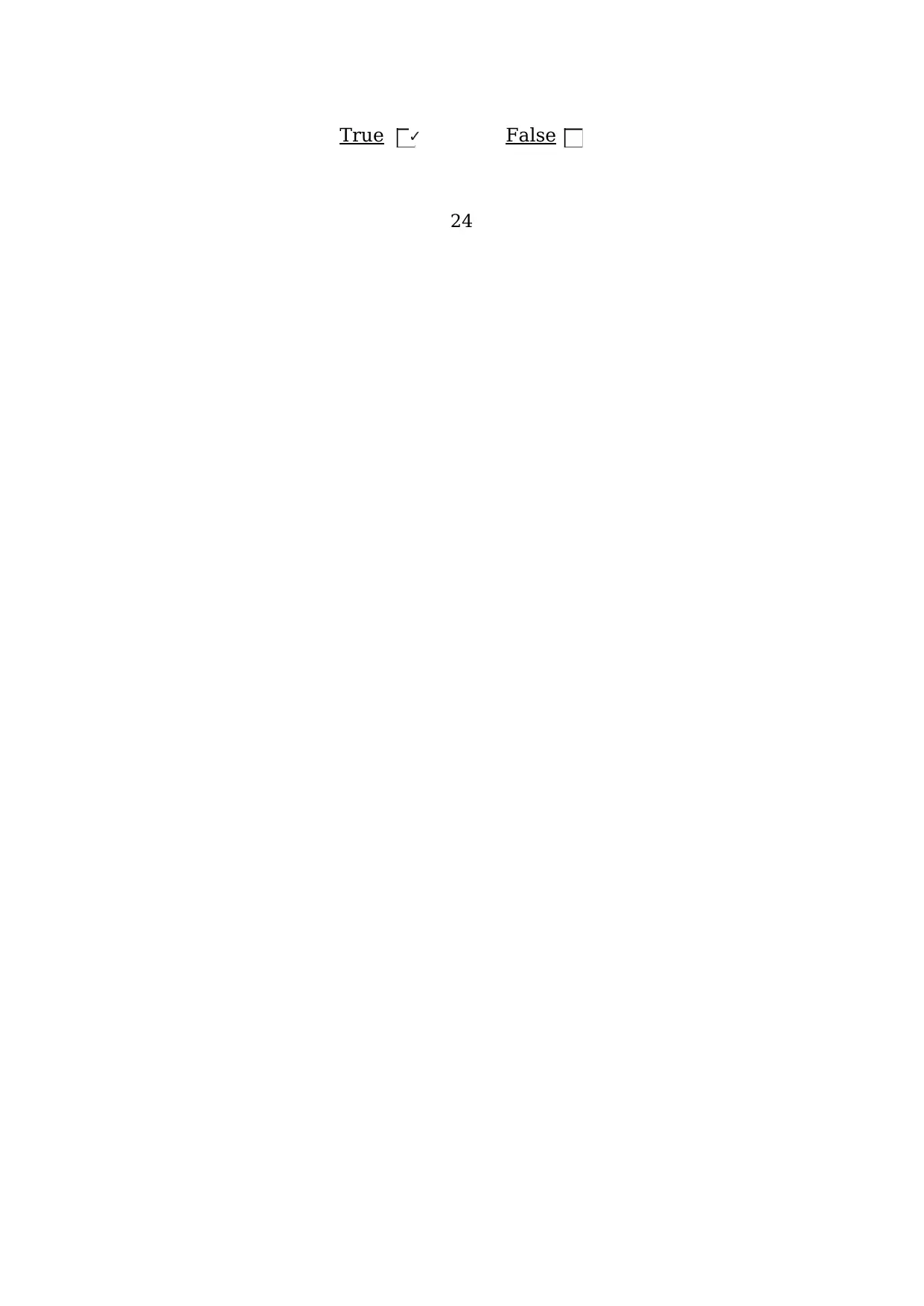
True ✓ False
24
24
Paraphrase This Document
Need a fresh take? Get an instant paraphrase of this document with our AI Paraphraser
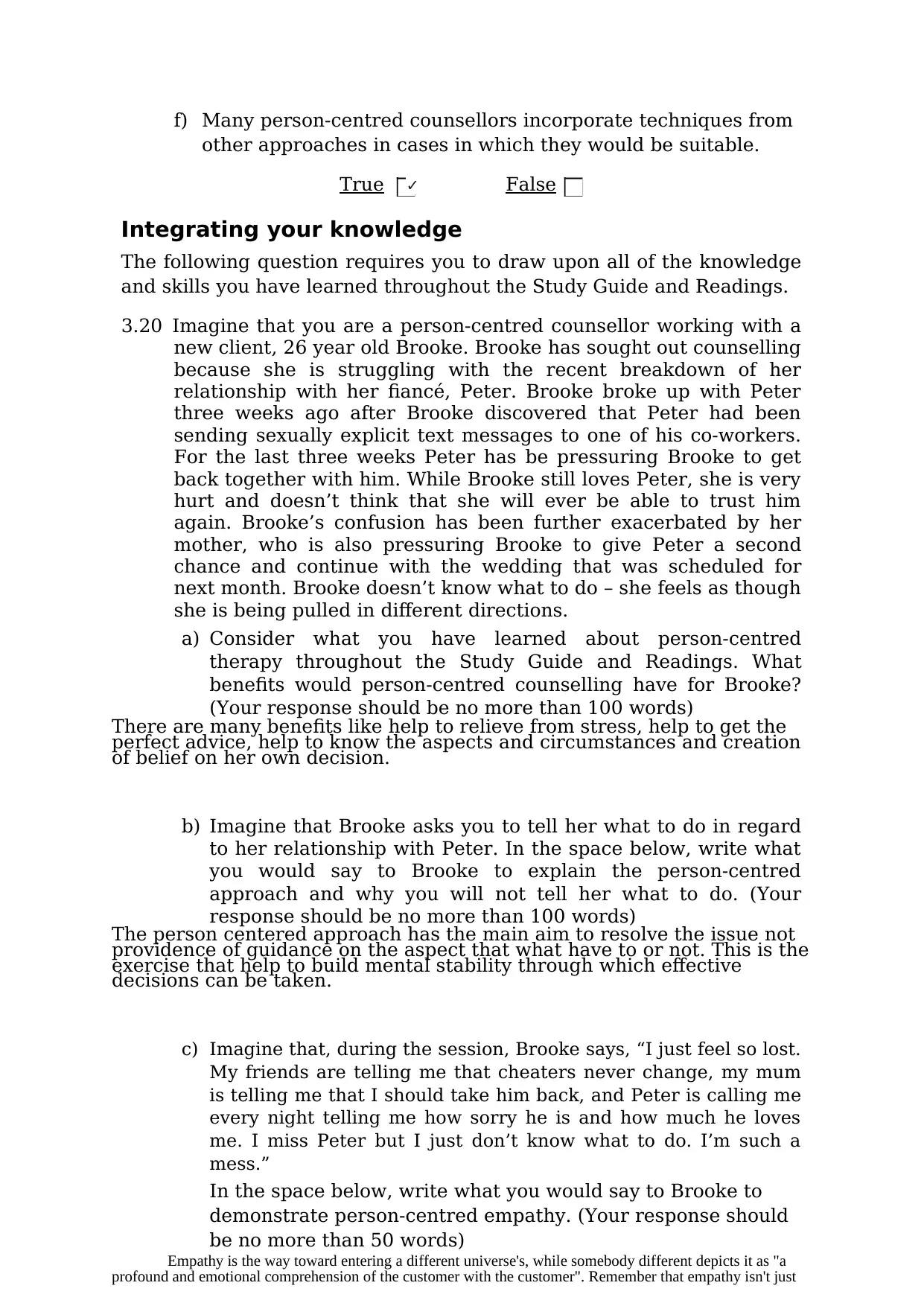
f) Many person-centred counsellors incorporate techniques from
other approaches in cases in which they would be suitable.
True ✓ False
Integrating your knowledge
The following question requires you to draw upon all of the knowledge
and skills you have learned throughout the Study Guide and Readings.
3.20 Imagine that you are a person-centred counsellor working with a
new client, 26 year old Brooke. Brooke has sought out counselling
because she is struggling with the recent breakdown of her
relationship with her fiancé, Peter. Brooke broke up with Peter
three weeks ago after Brooke discovered that Peter had been
sending sexually explicit text messages to one of his co-workers.
For the last three weeks Peter has be pressuring Brooke to get
back together with him. While Brooke still loves Peter, she is very
hurt and doesn’t think that she will ever be able to trust him
again. Brooke’s confusion has been further exacerbated by her
mother, who is also pressuring Brooke to give Peter a second
chance and continue with the wedding that was scheduled for
next month. Brooke doesn’t know what to do – she feels as though
she is being pulled in different directions.
a) Consider what you have learned about person-centred
therapy throughout the Study Guide and Readings. What
benefits would person-centred counselling have for Brooke?
(Your response should be no more than 100 words)
There are many benefits like help to relieve from stress, help to get the
perfect advice, help to know the aspects and circumstances and creation
of belief on her own decision.
b) Imagine that Brooke asks you to tell her what to do in regard
to her relationship with Peter. In the space below, write what
you would say to Brooke to explain the person-centred
approach and why you will not tell her what to do. (Your
response should be no more than 100 words)
The person centered approach has the main aim to resolve the issue not
providence of guidance on the aspect that what have to or not. This is the
exercise that help to build mental stability through which effective
decisions can be taken.
c) Imagine that, during the session, Brooke says, “I just feel so lost.
My friends are telling me that cheaters never change, my mum
is telling me that I should take him back, and Peter is calling me
every night telling me how sorry he is and how much he loves
me. I miss Peter but I just don’t know what to do. I’m such a
mess.”
In the space below, write what you would say to Brooke to
demonstrate person-centred empathy. (Your response should
be no more than 50 words)
Empathy is the way toward entering a different universe's, while somebody different depicts it as "a
profound and emotional comprehension of the customer with the customer". Remember that empathy isn't just
other approaches in cases in which they would be suitable.
True ✓ False
Integrating your knowledge
The following question requires you to draw upon all of the knowledge
and skills you have learned throughout the Study Guide and Readings.
3.20 Imagine that you are a person-centred counsellor working with a
new client, 26 year old Brooke. Brooke has sought out counselling
because she is struggling with the recent breakdown of her
relationship with her fiancé, Peter. Brooke broke up with Peter
three weeks ago after Brooke discovered that Peter had been
sending sexually explicit text messages to one of his co-workers.
For the last three weeks Peter has be pressuring Brooke to get
back together with him. While Brooke still loves Peter, she is very
hurt and doesn’t think that she will ever be able to trust him
again. Brooke’s confusion has been further exacerbated by her
mother, who is also pressuring Brooke to give Peter a second
chance and continue with the wedding that was scheduled for
next month. Brooke doesn’t know what to do – she feels as though
she is being pulled in different directions.
a) Consider what you have learned about person-centred
therapy throughout the Study Guide and Readings. What
benefits would person-centred counselling have for Brooke?
(Your response should be no more than 100 words)
There are many benefits like help to relieve from stress, help to get the
perfect advice, help to know the aspects and circumstances and creation
of belief on her own decision.
b) Imagine that Brooke asks you to tell her what to do in regard
to her relationship with Peter. In the space below, write what
you would say to Brooke to explain the person-centred
approach and why you will not tell her what to do. (Your
response should be no more than 100 words)
The person centered approach has the main aim to resolve the issue not
providence of guidance on the aspect that what have to or not. This is the
exercise that help to build mental stability through which effective
decisions can be taken.
c) Imagine that, during the session, Brooke says, “I just feel so lost.
My friends are telling me that cheaters never change, my mum
is telling me that I should take him back, and Peter is calling me
every night telling me how sorry he is and how much he loves
me. I miss Peter but I just don’t know what to do. I’m such a
mess.”
In the space below, write what you would say to Brooke to
demonstrate person-centred empathy. (Your response should
be no more than 50 words)
Empathy is the way toward entering a different universe's, while somebody different depicts it as "a
profound and emotional comprehension of the customer with the customer". Remember that empathy isn't just
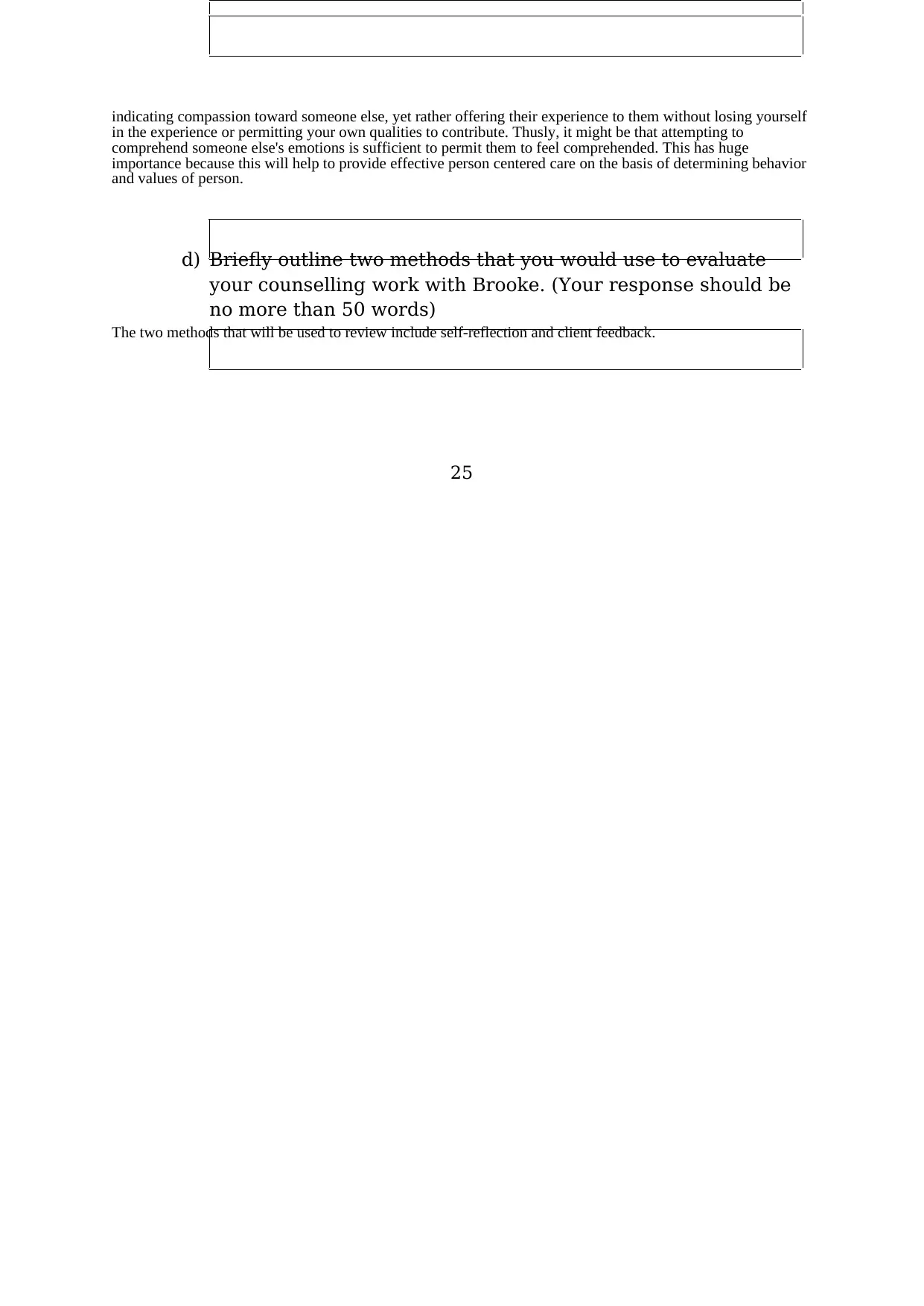
indicating compassion toward someone else, yet rather offering their experience to them without losing yourself
in the experience or permitting your own qualities to contribute. Thusly, it might be that attempting to
comprehend someone else's emotions is sufficient to permit them to feel comprehended. This has huge
importance because this will help to provide effective person centered care on the basis of determining behavior
and values of person.
d) Briefly outline two methods that you would use to evaluate
your counselling work with Brooke. (Your response should be
no more than 50 words)
The two methods that will be used to review include self-reflection and client feedback.
25
in the experience or permitting your own qualities to contribute. Thusly, it might be that attempting to
comprehend someone else's emotions is sufficient to permit them to feel comprehended. This has huge
importance because this will help to provide effective person centered care on the basis of determining behavior
and values of person.
d) Briefly outline two methods that you would use to evaluate
your counselling work with Brooke. (Your response should be
no more than 50 words)
The two methods that will be used to review include self-reflection and client feedback.
25

e) Imagine that, as a result of your monitoring and evaluation
processes, you identified a need to improve your skills in the
use of the person-centred approach. List three steps that you
would take to enhance your person-centred counselling skills
and ensure that you were using up-to-date processes? (Your
response should be no more than 50 words)
The three steps that help to improve includes professional development, learning, training and peer guidance.
26
processes, you identified a need to improve your skills in the
use of the person-centred approach. List three steps that you
would take to enhance your person-centred counselling skills
and ensure that you were using up-to-date processes? (Your
response should be no more than 50 words)
The three steps that help to improve includes professional development, learning, training and peer guidance.
26
Secure Best Marks with AI Grader
Need help grading? Try our AI Grader for instant feedback on your assignments.
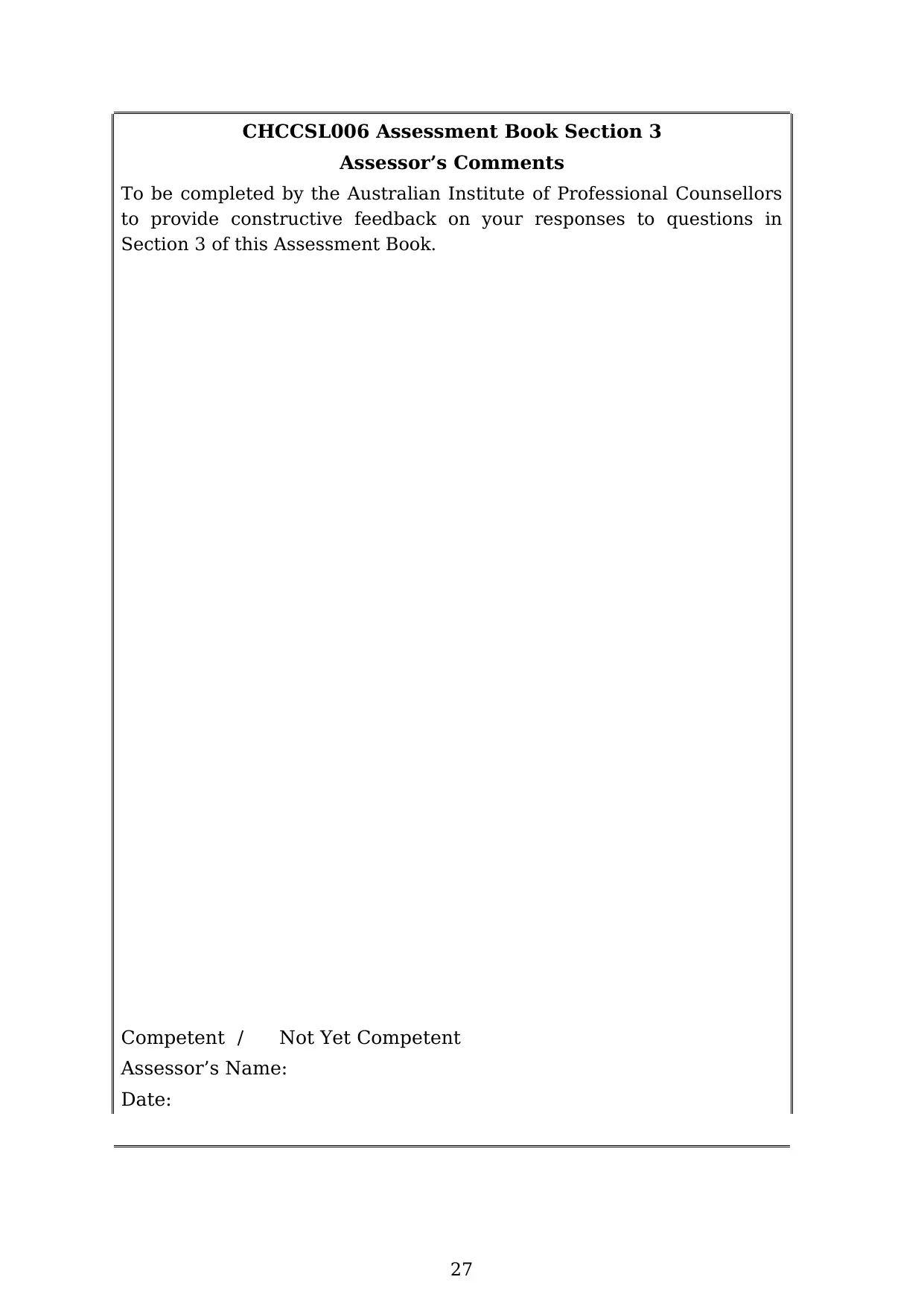
CHCCSL006 Assessment Book Section 3
Assessor’s Comments
To be completed by the Australian Institute of Professional Counsellors
to provide constructive feedback on your responses to questions in
Section 3 of this Assessment Book.
Competent / Not Yet Competent
Assessor’s Name:
Date:
27
Assessor’s Comments
To be completed by the Australian Institute of Professional Counsellors
to provide constructive feedback on your responses to questions in
Section 3 of this Assessment Book.
Competent / Not Yet Competent
Assessor’s Name:
Date:
27
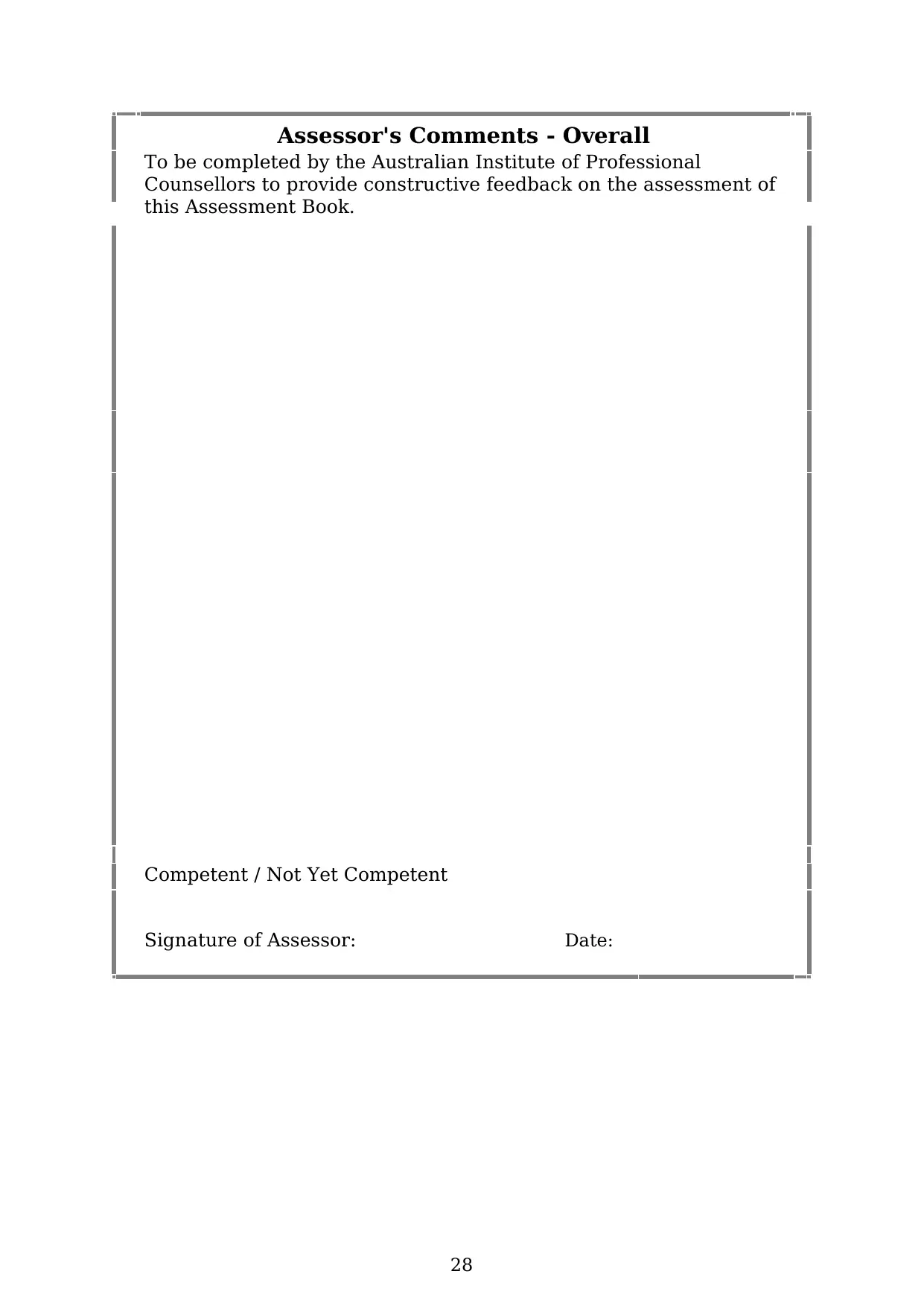
Assessor's Comments - Overall
To be completed by the Australian Institute of Professional
Counsellors to provide constructive feedback on the assessment of
this Assessment Book.
Competent / Not Yet Competent
Signature of Assessor: Date:
28
To be completed by the Australian Institute of Professional
Counsellors to provide constructive feedback on the assessment of
this Assessment Book.
Competent / Not Yet Competent
Signature of Assessor: Date:
28
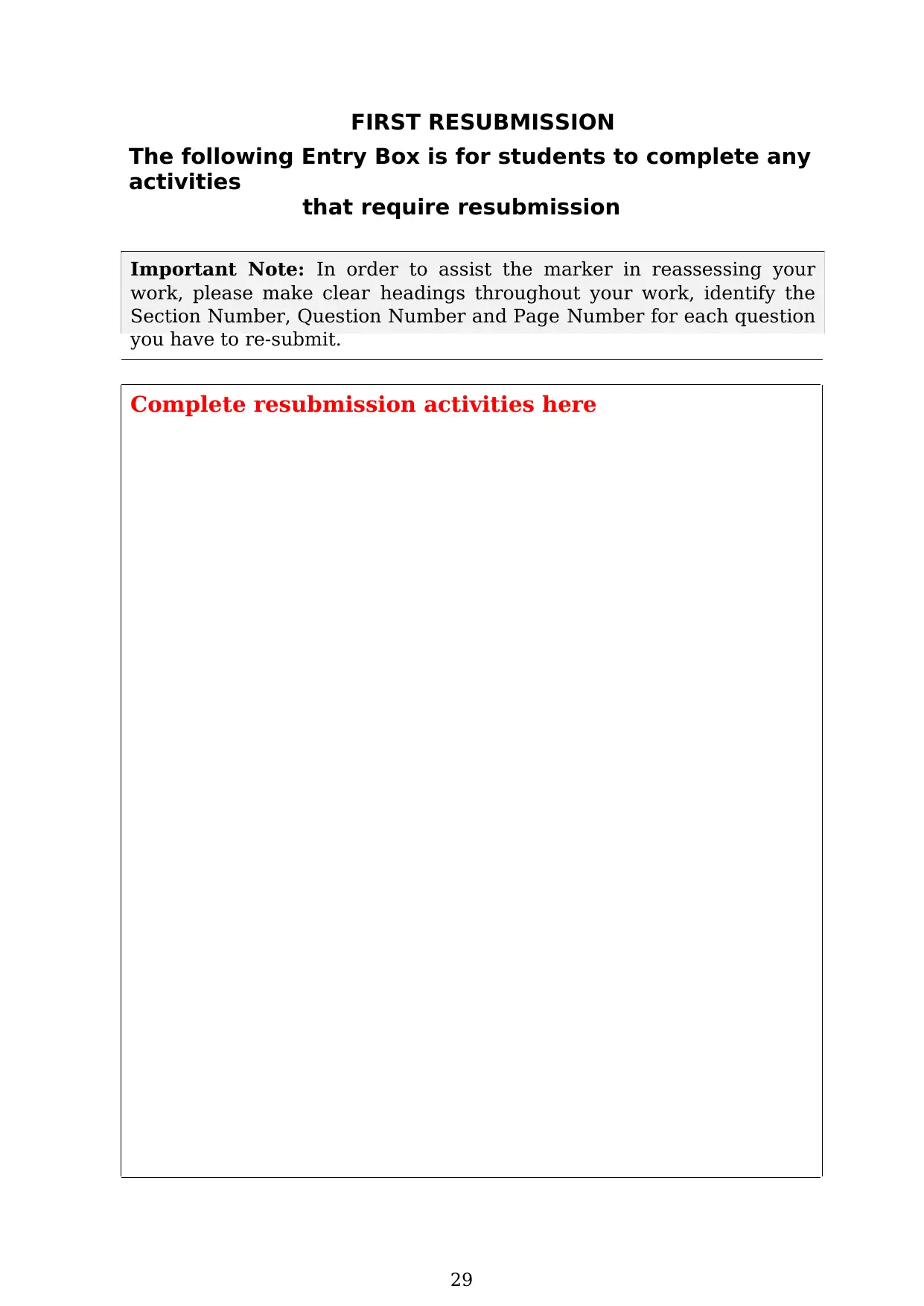
FIRST RESUBMISSION
The following Entry Box is for students to complete any
activities
that require resubmission
Important Note: In order to assist the marker in reassessing your
work, please make clear headings throughout your work, identify the
Section Number, Question Number and Page Number for each question
you have to re-submit.
Complete resubmission activities here
29
The following Entry Box is for students to complete any
activities
that require resubmission
Important Note: In order to assist the marker in reassessing your
work, please make clear headings throughout your work, identify the
Section Number, Question Number and Page Number for each question
you have to re-submit.
Complete resubmission activities here
29
Paraphrase This Document
Need a fresh take? Get an instant paraphrase of this document with our AI Paraphraser

Assessor's Comments – First Resubmission
To be completed by the Australian Institute of Professional
Counsellors to provide constructive feedback on the first
resubmission of this Assessment Book.
Competent / Not Yet Competent
Signature of Assessor: Date:
30
To be completed by the Australian Institute of Professional
Counsellors to provide constructive feedback on the first
resubmission of this Assessment Book.
Competent / Not Yet Competent
Signature of Assessor: Date:
30
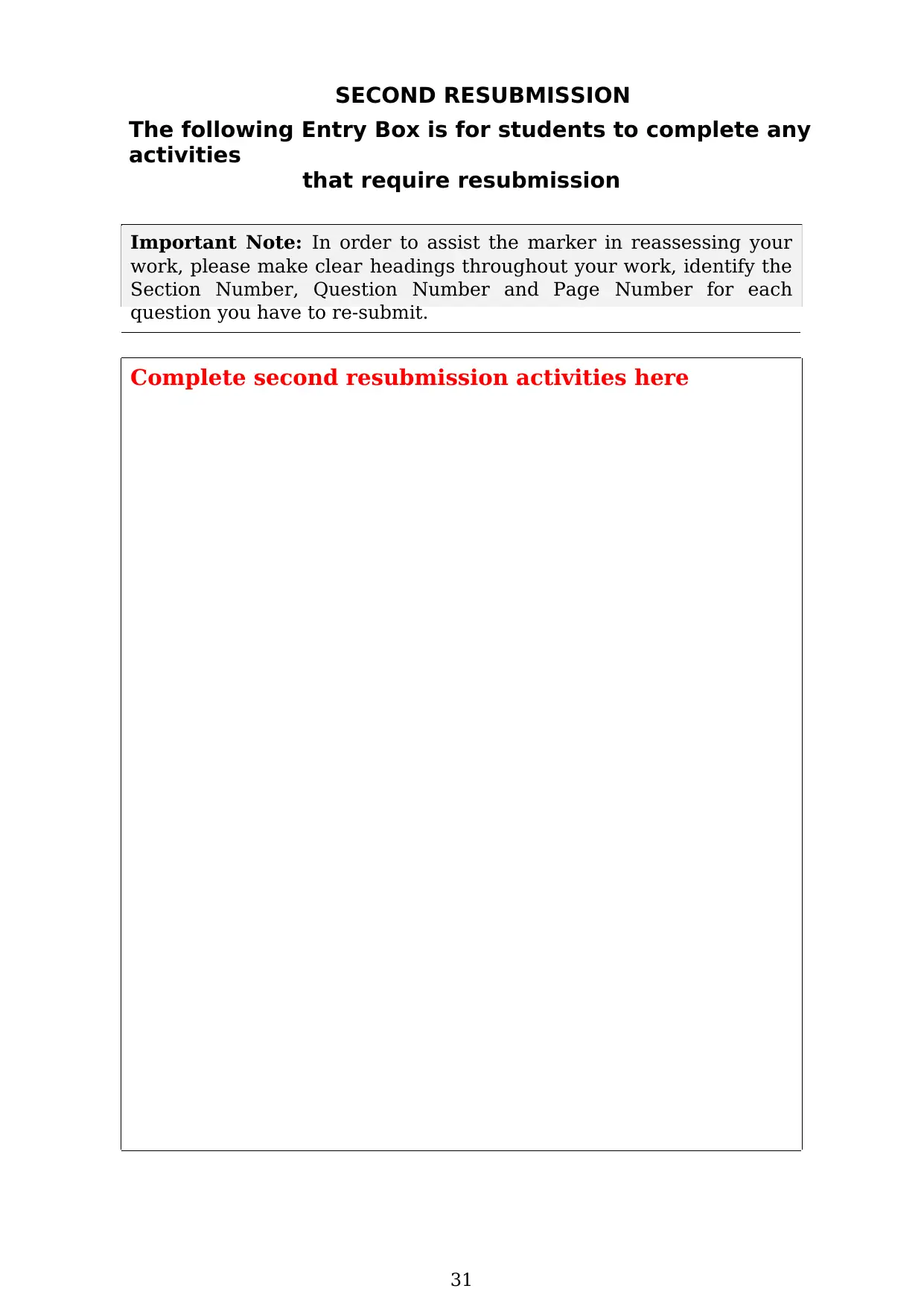
SECOND RESUBMISSION
The following Entry Box is for students to complete any
activities
that require resubmission
Important Note: In order to assist the marker in reassessing your
work, please make clear headings throughout your work, identify the
Section Number, Question Number and Page Number for each
question you have to re-submit.
Complete second resubmission activities here
31
The following Entry Box is for students to complete any
activities
that require resubmission
Important Note: In order to assist the marker in reassessing your
work, please make clear headings throughout your work, identify the
Section Number, Question Number and Page Number for each
question you have to re-submit.
Complete second resubmission activities here
31
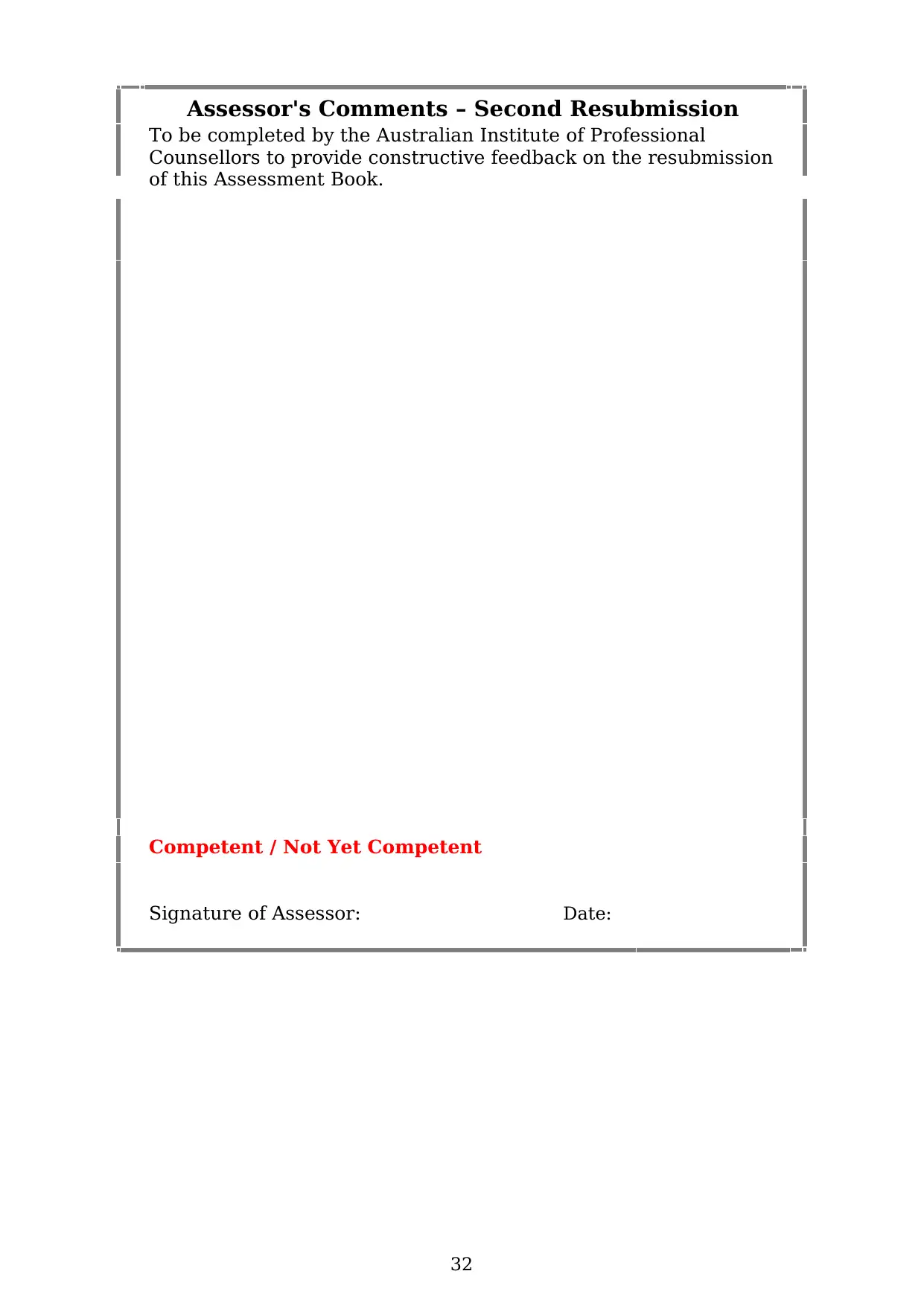
Assessor's Comments – Second Resubmission
To be completed by the Australian Institute of Professional
Counsellors to provide constructive feedback on the resubmission
of this Assessment Book.
Competent / Not Yet Competent
Signature of Assessor: Date:
32
To be completed by the Australian Institute of Professional
Counsellors to provide constructive feedback on the resubmission
of this Assessment Book.
Competent / Not Yet Competent
Signature of Assessor: Date:
32
1 out of 52
Related Documents
Your All-in-One AI-Powered Toolkit for Academic Success.
+13062052269
info@desklib.com
Available 24*7 on WhatsApp / Email
![[object Object]](/_next/static/media/star-bottom.7253800d.svg)
Unlock your academic potential
© 2024 | Zucol Services PVT LTD | All rights reserved.





